Signals

December November 2009 February 2010 Number 89


The museum’s unique venues, sweeping city skyline, water views and fine catering will make your wedding day one to remember!
Drinks on destroyer Vampire … dinner for 150 in the elegant Terrace Room ... harbourside Yots Café … or up to 300 in our North Wharf marquee (mid-November to mid-December).
Award-winning Bayleaf Catering is renowned for innovation, quality menus and fine service delivery. A special place to

02 9298 3649
email venues@anmm.gov.au www.anmm.gov.au/venues

tie the knot
December 2009 to February 2010 Number 89 2 10
Signals
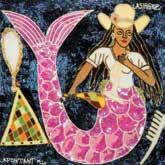


2 Mythic Creatures: Dragons, Unicorns & Mermaids
The fantastic creatures that populate human belief, storytelling, music, literature and art
10 Omai relics from the Furneaux collection
Three 18th-century artefacts of impeccable provenance, from Cook’s second voyage
16 Weapons of the Boxer uprising
Arms associated with an Imperial adventure
21 Members events
Talks, tours, cruises, seminars, children’s events … summer calendar for Members
26 What’s on
Summer exhibitions, events and activities for visitors
30 Sail on Endeavour in 2010
Get afloat on the replica of Cook’s famous ship
32 The floating world of Cambodia
Our exclusive overseas tour casts a maritime light on the world-renowned temples of Angkor
34 Whaling linked our nations
An essay by the first USA Gallery Fellowship holder
cover: Detail from a sequined Voudou flag from Haiti, showing the mermaid Lasirén, a water spirit popular in the Caribbean Islands and parts of the Americas. It’s part of the lively travelling exhibition Mythic Creatures: Dragons, Unicorns & Mermaids opening here for the summer and autumn. The exhibition was organised by the American Museum of Natural History, New York (www.amnh.org) in collaboration with the Australian National Maritime Museum and leading North American institutions. Photographer D Finnin, reproduced courtesy of the American Museum of Natural History

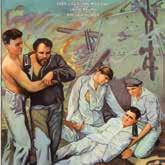
40 Tales from the Welcome Wall
Hazem El Masri, Aussie football legend from war-torn Beirut
42 Collections
Emden the movie with a German viewpoint
44 Reading
The Female Shipwright; winner of 2009 Frank Broeze maritime history book prize
46 Currents
Intern from New Caledonia; harourside events
48 Bearings
From the director
34 42 32 Contents
Mythic creatures
Dragons, Unicorns & Mermaids

SIGNALS 89 DECEMBER 2009–FEBRUARY 2010 2

For thousands of years, fantastic mythical creatures have appeared in human beliefs, storytelling, music, literature and art. We worked with the American Museum of Natural History to develop an international travelling exhibition investigating the origins and evolution of these powerful images, revealing how they continue to thrill, terrify, entertain and enchant us today.
Since people first started telling stories, mythical creatures – from fire-breathing dragons, magical unicorns and mesmerising mermaids to the soaring phoenix or the one-eyed Cyclops – have captured the human imagination. Some symbolise danger and fear of the unknown, others are believed to possess supernatural powers, or to bring good fortune and happiness. Together they reflect human attempts to describe and explain the mysteries of the natural world and to give form and substance to our most powerful fears, beliefs and dreams.
Now an amazing exhibition – Mythic Creatures: Dragons, Unicorns & Mermaids – taps into this primal fascination, demonstrating the enduring allure of these mythological beings and revealing the common cultural roots that link us all.
The Australian National Maritime Museum helped to develop this exhibition from the American Museum of Natural History, New York, along with other leading North American institutions. It uses life-sized models, interactives, specimens and fossils, soundscapes and other multimedia to explore these fascinating creatures, tracing their origins in oral traditions and their evolution over time and around the globe.
Mythic creatures illustrate the uniquely human capacity for symbolic expression and creativity. Yet however fantastic they might appear, many have their roots in the real world.
Misidentification, speculation, fear or exaggeration can inspire tall tales as people seek to make sense of the world around them. The dragon, for example, can be traced back to real-life fossils. Long before palaeontology developed as a science, people unearthed fossilised
left: Stories of the vampire-like Chupacabra (‘goat sucker’ in Spanish) emerged from a wave of alleged sightings by Puerto Rican farmers in the late 1980s and early 1990s. It has entered popular American culture.
opposite: The Caribbean mermaid Lasirén depicted on a Voudou flag from Haiti. The name Lasirén comes from the French sirène, meaning siren or mermaid, after the bird-women of ancient Greek mythology who lured sailors with song.
All photographs by D Finnin, reproduced courtesy of the American Museum of Natural History, unless otherwise credited.
bones and took them for the remains of monsters. It’s easy to understand how the remains of the gigantic, reptilian Tyrannosaurus rex with its threatening teeth and claws could conjure up images of a terrifying dragon.
Through paintings, sculptures, textiles, ceramics, costumes and other fascinating artefacts from cultural traditions across North America, Europe, Asia and beyond, the exhibition explores this relationship between nature and legend and its influence on human behaviour, creative expression and belief systems.
Creatures of the deep
The idea that something may be lurking in the deep has long haunted people of all cultures. Tales of mysterious sea monsters brought back by early sailors don’t appear very accurate to us, but such ‘witness’ accounts were the only source of information available at the time. Often the descriptions incorporated features of actual marine animals. This is true of the mermaid – half-woman, half-fish – perhaps the most popular mythical sea creature represented across numerous cultures, but most likely based on sightings of dugongs or manatees. Famed for luring unwary sailors to their death by enchanting them with their singing, mermaids were reputed to be beautiful, seductive and dangerous – like the sea itself. They were often depicted carrying a comb and mirror, symbols of beauty and vanity, a detail that passed from European to African and Caribbean cultures.
Incarnations of the mermaid include the treacherous sirens of Greek mythology and the powerful African water spirit Mami Wata, who brings good fortune to her followers but will drown anyone
SIGNALS 89 DECEMBER 2009–FEBRUARY 2010 3
Major sponsor


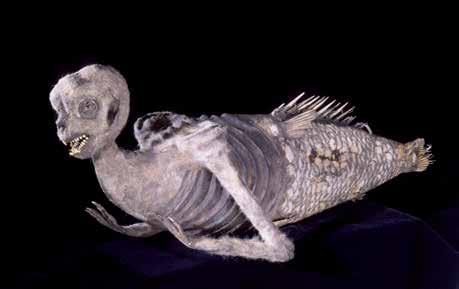
who disobeys her. The Haitian mermaid Lasirén is a revered figure in the Voudou tradition, who some say takes people to her underwater world and returns them with new powers. Sedna is the mermaidlike sea goddess of Inuit culture. According to legend, a father tossed his daughter overboard into the sea on a wild and stormy night, and then chopped off her fingers as she clung to the side of the boat. Her fingers became the whales, seals, and walruses on which the Inuit depend for their survival. In an instance of cross-cultural interchange, Sedna was not depicted as half-fish until the arrival of European whalers whose tales of mermaids probably influenced this legend.
An Australian contribution to the exhibition are the Yawkyawks, female ancestor spirits of Indigenous Australian legend. Half-spirit, half-fish, these ancestral beings are said to inhabit
waterways and billabongs, and closely resemble the European notion of mermaids, enticing the unwary beneath the water. The Yawkyawk (meaning ‘young girl’) is a powerful symbol of fertility. It provides drinking water and rain but, if angered, will bring storms. Some stories say that it grows legs at night to walk on land, or changes into a dragonfly at the end of the dry season. Some tales of mythical sea monsters might have originated from wondrous real creatures such as the giant squid or the oarfish. The monstrous kraken of Scandinavian legend could well have been based on sightings of giant squid. Possibly the largest sea monster ever imagined, the multi-tentacled kraken lived in the seas near Norway and Iceland, with some stories describing them as more than 2.5 km in circumference, and with tentacles as large as a ship’s masts. Not quite that large, real giant squid can grow
far left: Yawkyawk sculpture, 2006, Lena Yarinkura, Central Arnhem Land. These female water spirits inhabit freshwater streams and pools.
ANMM collection
left: In East Asia the dragon embodies the powerful male principle and is often associated with military strength and martial arts. Japanese sword guard, called tsuba
below: Welcome back to the ‘Feejee mermaid’, a famous fake cobbled together from fish parts, papier mâché and wood. We first borrowed it from Peabody Museum in the USA in 1999 for our exhibition Secrets of the Sea. A mermaid like this was made famous by P T Barnum.
Photograph Harvard University, Peabody Museum 97-39-70/72853 T1383
right: The kraken, a mythical Norse sea monster, appears in the exhibition together with a giant squid tentacle in a specimen jar. The photograph shows the installation at the the American Museum of Natural History.
Mermaids were reputed to be beautiful, seductive and dangerous –like the sea itself
up to 20 metres long and have the largest eyes of any living creature – each eye can be the size of a human head! Other documented sea-monster sightings were probably cases of mistaken identity. Some of the sea serpents depicted on old maps appear to be based on the oarfish or ribbon fish, a rarely seen species with a long, ribbon-like body that can reach up to 11 metres. An extraordinary-looking crest of bright red spines decorates its head and a spiny dorsal fin runs down its back. Other monsters have turned out to be the carcasses of basking sharks (an immense fish up to nine metres in length), or even just large masses of floating seaweed. Reports of a long-necked lake creature such as Scotland’s Loch Ness Monster, or the Ogopogo reputed to haunt the lakes of British Columbia, have been attributed variously to sightings of logs, unusually large lake sturgeons or even relict populations of marine dinosaurs.
SIGNALS 89 DECEMBER 2009–FEBRUARY 2010 4

SIGNALS 89 DECEMBER 2009–FEBRUARY 2010 5


left: This three-metre-long dragon with a wingspan of four metres guards the entrance to Mythic Creatures: Dragons, Unicorns & Mermaids
below: The mythical giant Roc of Arabian literature swoops over a life-sized model of the creature that may have inspired its creation: the now extinct Aepyornis of Madagascar, the largest bird that ever lived.
SIGNALS 89 DECEMBER 2009–FEBRUARY 2010 6
The idea that something may be lurking in the deep has long haunted people of all cultures
creatures with divine powers, able to control the seasons and direct the flow of rivers, lakes and seas, a symbol of fertility and good fortune. Wingless, they reign over their watery realms during winter but rise to the heavens in spring with a clap of thunder and breathe clouds to bring monsoon rains for the agricultural season. Masters of transformation, they can shrink to fit in a teacup, or grow to fill the sky; they can also disappear or take the form of a fish, a snake or a human being.
eagle. Both the Aepyornis and Haast’s eagle died out around the 1500s and were therefore known to humans (who contributed to their demise).
Dragons
Dragons – probably the most famed and widespread of mythic creatures, with their earliest mention dating back thousands of years – claim a legendary presence on at least three continents, inhabiting the realms of land, water and the air.
Stories about legendary beasts embody cultural belief systems, identity and moral codes, and can evolve and change over time. When people from different societies interact, they often blend and borrow myths, stories, and images from their oral traditions, art, literature, dance, drama, music and celebrations. These exchanges explain why many different cultures share mythic creatures that are superficially similar in appearance, but may differ profoundly in symbolic meaning.
In European folklore, dragons are represented as wicked and dangerous reptilian beasts with formidable powers: they breathe fire, kill people with their poisonous breath, devour sheep and capture young maidens. Often winged, they live in marshes or deep inside caves, sometimes guarding piles of treasure. Reviled in the Christian tradition as the embodiment of Satan, the long scaly body and fangs recall the biblical serpent that tempted Adam and Eve. Dragons are often vanquished by a heroic and honourable knight, in a metaphorical victory of good over evil, virtue over sin. The legendary dragon slayer St George is a popular symbol of Christian faith. In Turkey and Syria, the dragon slayer is sometimes revered as Al Khidr, a Muslim patron of spring and fertility. By contrast, dragons in East Asian cultures are benevolent underwater
A symbol of masculine power, the dragon is often paired with the phoenix in Chinese art. Together they represent the harmony and union of the cosmic elements of yin (the feminine principle of coolness, darkness and repose) and yang (the masculine principle of heat, light and action). Revered above all other creatures in East Asian lore, the dragon is also a symbol of imperial rule. Stories from Persia (now Iran) also feature a dragon that resembles the Chinese version as a result of contact with Mongol invaders in the 1200s.
In the Americas, the ancient civilization of the Aztecs worshiped the dragon-like god Quetzalcoatl, or ‘feathered serpent’. God of the sky, rain and wind, Quetzalcoatl was also a symbol of power for priests and kings. He appears in many forms, often with the sharp fangs, fiery gaze and coiling body of a snake, and the deep green feathers of the quetzal (a beautiful tropical bird).
Winged mythological creatures
Some 700 years ago, Arab traders told of a colossal bird living on an island off the African coast that was so huge it could lift an elephant into the sky. Marco Polo wrote that to feed ‘it will seize an elephant in its talons and carry him high into the air, and drop him so that he is smashed to pieces’. The legendary Roc may have been based on a giant bird, the Aepyornis, which once lived on the island of Madagascar. Now extinct, this flightless bird – the largest ever to exist – was over three metres tall and laid the largest eggs in the world. The Roc appears in popular tales such as the adventures of Sindbad from The Arabian Nights, based on Arab spice voyages.
Maori myths describe a similarly large, predatory bird in New Zealand. This was probably the Haast’s eagle. Unlike the Aepyornis, this powerful predator not only could fly, it could attack at 80 km/h. Ironically its main prey was another mammoth bird, the flightless moa, which weighed up to 15 times as much as the
Other examples of mythical flying creatures are the bird-like divinity Garuda (now the national symbol of Thailand and Indonesia), and its eternal enemy, the serpent-like Naga – both of which are recurring symbols in Hindu and Buddhist iconography. Garuda has wings so large they darken the sky and can cause hurricanes, a human torso and often arms, the legs and clawed feet of a bird, and either a bird head or a human head with a beak. Nagas have the body of a snake and, often, a dragon-like face. They live underground in caves or jewelled palaces, and the Naga king supports the world, causing earthquakes when he moves.
An enduring symbol even today, Pegasus, the famous white-winged horse of Greek mythology, was a benign and loyal companion to heroes. Son of the monster Medusa and Poseidon, god of the sea and horses, Pegasus is said to have sprung fully formed from the neck of Medusa when she was beheaded by the hero Perseus. Perseus then climbed on Pegasus’ back and flew to safety.
Divine birds in the legends of Asia, Europe and the Middle East, such as the supremely powerful Asian phoenix, are often linked with fire and the Sun, symbolising renewal and good fortune. In ancient Egyptian mythology and the tales derived from it, the phoenix or bennu bird is a sacred firebird with beautiful gold and red plumage. At the end of its centuries-long life cycle, the phoenix builds a nest of cinnamon twigs that is then ignited by the Sun. Both nest and bird burn fiercely and are reduced to ashes, from which a new, young phoenix arises to begin life anew. Inspired by this tale, many poets and artists have adopted the phoenix as a symbol of renewal and rebirth.
The sphinx of Greek mythology was a terrible monster with a lion’s body, a woman’s head, and the wings of an eagle, that stood guard at the gates to the ancient city of Thebes, asking everyone to solve a riddle and devouring all who failed the test. The Greek version may have been inspired by a similar creature depicted 4,500 years ago in Egypt. Later Egyptian versions of the sphinx had the head of a ram, a falcon, or even a king (like the Great Sphinx of Giza, which depicts King Khafre who ruled around 2,500 bc). Egyptian sphinxes were considered benign symbols of royal power.
SIGNALS 89 DECEMBER 2009–FEBRUARY 2010 7

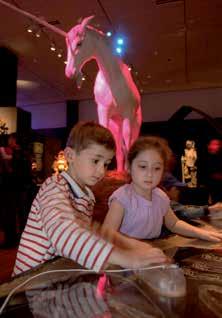
Unearthly creatures
Many mythical creatures are compilations of several ordinary animals, while others seem to have been inspired or reinforced by fossil remains. Before formal methods of scientific observation and interpretation were developed, a fleeting glimpse of an animal or the discovery of unfamiliar bones was often enough to confirm the existence of a legendary beast.
For example, the majestic griffin –combining the body of a lion with the head, talons and wings of an eagle –appears in many cultures across North Africa, the Middle East and Europe. Some experts believe that the legend originated in the sands of the Gobi Desert around 2,000 years ago, when Scythian nomads searching for gold stumbled upon the fossilised remains of the Protoceratops. This dinosaur lived from 145.5 to 65.5 million years ago, and combined a bird-like beak, four legs and elongated shoulder-blades that might suggest wings. The enormous bones of mammoths, mastodons, and woolly rhinoceroses could also have been the inspiration for tales of feared mythical giants. Perhaps the original inspiration for the one-eyed giant Cyclops was the fossilised skull of a dwarf elephant, its large central trunk cavity mistaken for a single eye-socket. Legendary hairy ape-men such as the Yeti of the Himalayas or Bigfoot (Sasquatch) of North America recur across many cultures. They have always managed to stay just out of sight, but scientists do know of one massive ape
that really did exist – Gigantopithecus blacki (a very distant relative of humans that lived in South-East Asia for almost a million years, until perhaps as recently as 300,000 years ago). It weighed nearly twice as much as a gorilla! It’s easy to understand how seeing a jawbone from this creature might lead to a belief in flesh-and-blood giants. Skeletal remains of a one-metre-tall hominid species Homo floresiensis were discovered recently in Indonesia, dated from 13,000 to 94,000 years before the present, which means they lived alongside Homo sapiens Nicknamed the Hobbit, its discovery tied in with local legends of dwarves.
Other mythical beings resemble familiar animals but have extraordinary features, such as the elusive and benevolent European unicorn, a horse with a single, long, spiralled horn believed to have curative properties for a range of illnesses, from epilepsy to the plague. A legend for over 2,000 years, the forestdwelling unicorn is usually depicted with a white coat, a beard. and sometimes cloven hooves and a tail like a lion. It was often used as a symbol for Christ. In the Middle Ages enterprising Scandinavian sailors brought back the tusks of the narwhal – a small Arctic whale whose extraordinary, elongated spiral incisor can grow to three metres in length – to sell as unicorn horns.
Mythic creatures can offer a perspective on how scientific discovery changes knowledge and beliefs over time. It is interesting to note that new animals continue to be ‘discovered’ to this day. The much-feared, vampire-like Chupacabra
far left: Reconstructed extinct primate Gigantopithecus – a distant relative of humans that lived in South-East Asia for almost a million years.
left: A three-metre-high white unicorn watches over Aidan Obstler and Sophie Edelman, engrossed in an interactive.
right: Sea monsters cavort in the waters off Iceland in this replica of an 1585 map drawn by Andreas Velleius. Reproduced courtesy Strachan and Vivian Donnelley
Mythic creatures give form and substance to our most powerful fears, beliefs and dreams
(Spanish for ‘goat sucker’) that has recently emerged in stories from Latin America and south-western United States is reported to kill animals by sucking their blood. According to the modern myth, which began with alleged sightings in Puerto Rico in the late 1980s, this dogsized beast has red eyes, large fangs and a pronounced backbone sometimes covered in sharp spines. It may walk on four legs or hop on two, like a kangaroo.
The exhibition
Highlights of Mythic Creatures include four larger-than-life models: a magnificent, three-metre-long winged dragon; a three-metre-high white unicorn; a Roc swooping overhead with large, sharp talons and a wingspan of nearly eight metres; and the multi-tentacled kraken, an enormous sea-monster whose massive head and tentacles appear to rise out of the floor as if from the sea. There are also two life-size models – an imposing reconstruction of the extinct giant primate Gigantopithecus, and
SIGNALS 89 DECEMBER 2009–FEBRUARY 2010 8
a three-metre-tall model of the largest bird ever to have lived, the extinct Aepyornis
Other highlights include a 36-metrelong Chinese parade dragon (used in New York’s Chinatown to perform the traditional dragon dance); a ‘Feejee mermaid’ of the type made famous in a spectacular hoax by showman P T Barnum (featuring the head and torso of a monkey sewn to the tail of a fish); the cast of a dwarf elephant skull; a Pegasus sculpture from a carousel; and a narwhal tusk of the sort once passed off as a unicorn’s horn, this one from the National Maritime Collection.
Visitors can use a touch-screen that allows them to build their own virtual dragon and then watch it come to life before their eyes. They can touch casts of a narwhal tusk, the lower jaw of Gigantopithecus, or a giant talon of the extinct Haast’s eagle. There are video interviews with award-winning artist Takeshi Yamada, creator of contemporary ‘mythic creatures’, and with artists from visual effects company Industrial Light and Magic (founded by George Lucas), demonstrating the process of creating dragons for popular movies such as Eragon
The final section of the exhibition focuses on the significance of mythic beasts today. Photographic portraits of diverse people are accompanied by quotes that capture how their own experiences with creatures from the mythic realm have informed their identity. They show that even in an age of science, we all still need a little magic.
Mythic creatures serve as powerful symbols of the human experience. Their forms and meanings are as diverse as their cultural origins. These often very ancient stories resonate today, referenced and reinterpreted by contemporary artists and writers – a testament to the power of their imagery and to their enduring appeal around the world.
Compiled by Penny Crino ANMM from texts supplied by AMNH
Mythic Creatures: Dragons, Unicorns and Mermaids is at the ANMM until 23 May 2010. The exhibition is organised by the American Museum of Natural History, New York (www.amnh.org) in collaboration with the Australian National Maritime Museum; The Field Museum, Chicago; the Canadian Museum of Civilization, Gatineau, Quebec; and Fernbank Museum of Natural History, Atlanta; and is proudly supported by MetLife Foundation and Channel Nine.
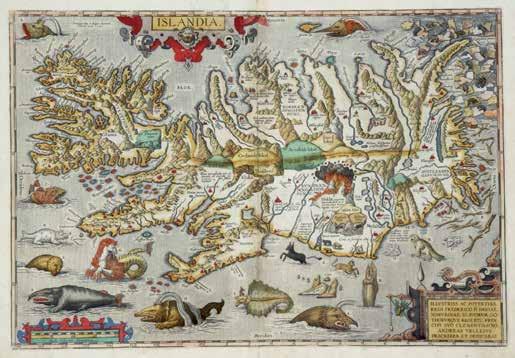
Mythic maritime morsels
• In the ocean near Haiti in 1493, Christopher Columbus – probably glimpsing a manatee – reported seeing three mermaids but said they were ‘not as pretty as they are depicted, for somehow in the face they look like men’.
• The Chinese leader of a huge naval expedition to Africa in the 15th century, the eunuch Admiral Zheng He, lent credence to myth when on his return he presented the Ming Emperor with a ‘live unicorn’ that was, in fact, a giraffe!
• Dragon’s blood was once prized as a medicine in Europe and the Middle East. Arab merchants sailed in their dhows to the Socotra Islands in the Arabian Sea to obtain resin from the fruit of the ‘dragon’s-blood’ tree.
• In Indigenous Australian lore, the bunyip lives in rivers, lakes and swamps and eats women and children. The legend may have originated with the Diprotodon, a threemetre-long marsupial that lived in Australia during the Pleistocene period.
• According to Vietnamese legend, the rocky islands of Ha Long (‘Descending Dragon’) Bay were spat out by a dragon that guarded the country in ancient times.
• In Japanese lore, kappa are small creatures with a face like a monkey, green scaly skin and a shell like a turtle. Pretending to be a human child, kappa would pull people underwater and eat them. Like the ahuizotl and the bunyip, the modern kappa has a far more child-friendly image, popularised in toys, movies and books.

• A dragon king was said to live in a pond at Shinzen’en, the imperial garden of Kyoto. During times of drought, Buddhist monks held ceremonies there to persuade the dragon king to rise and bring rain.
• On the island of Borneo, the dragon is a goddess of the underworld. She protects the living, guards the dead and is associated with earth, water, thunder and lightning.
• The Aztecs of Mexico described the ahuizotl as a dog-like creature that lived at the bottom of deep pools of water. It would cry at night like a baby to lure people near, and pull them into the water with a hand located at the tip of its long coiled tail.
• The mythic Nasca killer whale of Peru is often shown with hands instead of fins, and a human head. The Nasca people, who lived along the coast of South America from around AD 1 to 700, collected and ritually preserved human skulls.
• Mishepishu, the horned and scaled lynxlike water spirit revered in Native-American Ojibwa lore, is feared for its power to stir up storms and sink boats.
SIGNALS 89 DECEMBER 2009–FEBRUARY 2010 9
Omai Relics from the Furneaux Collection
Three important Polynesian artefacts – weapons collected during Cook’s second circumnavigation (1772–75) – have been purchased from a private vendor with the assistance of funding from the Australian Government’s National Cultural Heritage Account. Their association with the famous Polynesian Omai, who returned to England with Cook, is explained by curator Dr Stephen Gapps.

In November of 1773, during James Cook’s second great circumnavigation of the world, Captain Tobias Furneaux was in Queen Charlotte Sound in New Zealand where he had spent some time repairing his ship HMS Adventure. The Maori people whom he met there were most cooperative in trading food and goods. Just before weighing anchor and attempting to rejoin the other ship in his company – the Resolution under Captain James Cook – he sent a final shore party to forage for ‘wild greens’, a crucial source of fresh food for explorers in the South Pacific.
Yet the shore party failed to return. A Maori law had probably been broken and the next day the ‘melancholy news’
arrived that ‘relicks’, ‘entrails’ and ‘baskets of human flesh’ were all that remained of the ten crewmen. Furneaux was able to account for John Rowe – one of his kinsman in the crew – by means of a severed hand that was recognisable because of an old, small wound on it. Part of another crewman, Thomas Hill, was identified since he had (with some foresight!) had his initials ‘T H’ tattooed on his hand in Tahiti only weeks before. He at least received a partial burial.
SIGNALS 89 DECEMBER 2009–FEBRUARY 2010 10
One of the Maori weapons that could have figured significantly in the violence at Queen Charlotte Sound was the patu – a short, single-handed weapon that the Maori used in close combat, in the manner of a slashing club. The hole drilled through the handle held a string that aided in gripping the weapon and enabled it to be easily slung at the waist. Patu were sharply edged in order to slash at an enemy, and could be used to dissect
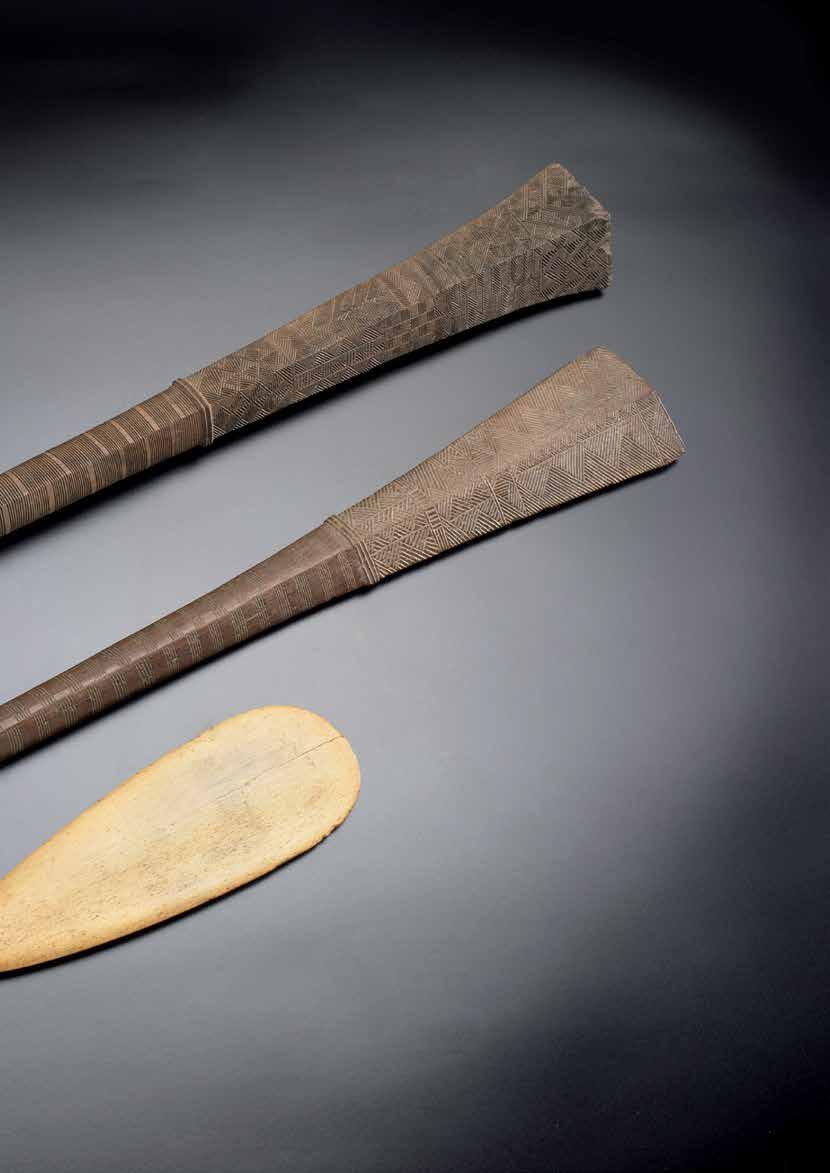
dead flesh. They could also be made from wood or basalt. These weapons were much admired by Joseph Banks who had a series of them made in brass, which he intended to take back to the Pacific with him – although in the end he never returned.
When looking at surviving examples of these weapons, the artistry of such skilfully carved pieces can distract the observer from the violence that occurred in many encounters between Europeans and indigenous peoples in the Pacific. Such weapons also reflect the material and social exchanges between cultures that occurred during 18th-century voyages of exploration – exchanges that rapidly and profoundly transformed both indigenous and European societies.
The three weapons pictured here have recently been acquired by the Australian National Maritime Museum. Their journey to the museum began with Cook’s second voyage, from 1772 to 1775, to search the southern oceans for Terra Australis Incognita – the unknown southern land whose existence, European geographers had long hypothesised, should balance the continents of the northern hemisphere.
Our new acquisitions: a whalebone Maori hand-axe or club (patu paraoa) from Queen Charlotte Sound in New Zealand, and two wooden clubs (akua-ta) from Tongatapu in the Tonga group. Photographer A Frolows/ANMM
SIGNALS 89 DECEMBER 2009–FEBRUARY 2010 11
Rarely does a set of 18th-century Pacific objects with such extraordinary provenance become available
The whalebone patu paraoa was probably collected just before the violence broke out at Queen Charlotte Sound, during a period of trading between the crew of the Adventure and the local Maori. Although Furneaux himself appears not to have been overly involved in the often frenzied collecting of ‘artificial curiosities’ manufactured by Pacific Islanders – a lucrative sideline for crews, in response to growing public interest in the discoveries of this great age of scientific voyages – he did return to England with a number of artefacts including these three.
The other two weapons acquired by the museum were collected earlier in the expedition when Furneaux and Cook’s ships were at the island of Tongatapu, part of modern day Tonga. They are two-handed wooden clubs known as akua-ta. Most Tongan clubs were made from the hard, heavy wood of the toa tree. Carved designs varied, but commonly include the cross-hatched styles seen here. One of the clubs has a patterned group of drill holes at the top that indicate previous attachments. Some surviving clubs have shell inlay on this section, which indicated a high social status.
In Tongatapu, Cook forbade private trading until the provisioning of the ships was completed. The crews were then given ‘leave to purchase what curiosities and other things they pleased’, which they did with exuberance. Cook noted how their desperation to secure ‘curiosities’ even came to be ridiculed by the Tongans, with ‘one waggish Boy’ taking a ‘piece of human excrement on the end of a stick and hild it out to every one of our people he met with’.
These three objects carried home by Furneaux during Cook’s second voyage form part of what became known as the ‘Omai Relics’ due to their association with Omai, the most famous Polynesian of the
18th century. The events at Queen Charlotte Sound and the trading at Tongatapu were witnessed by a young Polynesian man on board the Adventure Listed on the ship’s muster as ‘Tetuby Homey, Huahine, Society Islands, 22, AB’, ‘Homey’ or Omai (correctly pronounced ‘mai’) was born around 1753 on the island of Raiatea just to the west of Tahiti. When he was about ten years of age, the island was invaded by people of the neighboring island Bora Bora, and Omai’s family fled to Tahiti.
Unfortunately Omai didn’t escape violence there either. In 1767 Captain Samuel Wallis and HMS Dolphin arrived, the first English navigator to reach the Tahitian islands group, and a short but bloody conflict occurred with the Dolphin’s guns crushing Tahitian resistance. Omai was among the women and children who had gathered for safety on One Tree Hill and were raked by British cannon fire.
Over the next few years Omai witnessed several European ships call at the Tahitian islands. In 1768 the Boudeuse and Etoile under Comte Louis-Antoine de Bougainville arrived, followed by the Endeavour under Lieutenant James Cook in 1769. Both commanders were eager to take someone from these newly discovered societies back to Europe, after first employing them as pilots, translators and cultural go-betweens while in the Pacific. The French ships brought a Tahitian man Aotourou to Paris in 1769 and Joseph Banks took another, Tupaia, on board the Endeavour
Aotourou arrived safely in Paris and created great scientific and popular interest. However Tupaia, after assisting the Endeavour crew in negotiations with Maori in New Zealand and then travelling along the east coast of Australia, died along with many of the Endeavour complement in Batavia, the disease-ridden port on the island of Java that was the administrative centre of the Dutch East Indies.
When Omai was a young boy sheltering from the English guns with his family on One Tree Hill, he could hardly have imagined his fate would become entwined with a crew member of the ship that was firing at him. Aboard the Dolphin was Lieutenant Tobias Furneaux, a career naval officer who gained a reputation during the Dolphin’s Pacific voyage as ‘patient in negotiations with natives’. Appointed captain of the Adventure in 1771, Furneaux was a natural choice to sail with Cook and the Resolution on Cook’s second voyage to the Pacific in 1772.
While scouring the high latitudes of the Southern Ocean, the Adventure and Resolution were separated by storms. Furneaux resupplied at Bruny Island in Tasmania and was reunited with Cook in New Zealand. When they eventually arrived at the Polynesian island of Huahine (not far from Tahiti) in September 1773, Omai, now around 20 years of age, was among the crowds visiting and trading with the European ships. Perhaps Omai was genuinely interested in the sheer adventure of seeing Europe first-hand when he approached the British to take him with them. But he also made it clear that he wished to obtain European weapons with which to take revenge upon the Bora Bora people who had forced him from his native island of Raiatea.
The Polynesian sailed away with Cook and Furneaux. He was with them in Tongatapu in October 1773, when the visitors traded for the two wooden clubs from the islanders. And he was there at Queen Charlotte Sound when the whalebone patu was collected, before the tragic loss of the expedition crewmen.
Omai was to become the most famous Polynesian of the great age of Pacific exploration. Interest in his arrival in England had been well prepared by published journal accounts and sailors’ tales of the Pacific islands. Omai came from a land and society that explorers and sailors described as a paradise – both literally and metaphysically far from the world that they knew. The Polynesian would bring a new reality to European imaginings of the Pacific islands.
Omai’s arrival in England in 1774 caused a sensation. The existence of such a handsome, well-mannered and intelligent ‘noble savage’ ignited intellectual and popular debates about the origins and destinies of human societies.
top: Four-fold decorated screen believed to date c. 1800 shows the clash, witnessed by the young Omai, between the Tahitians and Captain Samuel Wallis in the Dolphin (with Lieutenant Tobias Furneaux on board). The 1840 mm x 2192 mm screen, painted on canvas stretched over a wooden frame, is derived from an engraving published in Hawkesworth’s Voyages, Vol 1, plate 21 (1773). It was possibly used as a display for a travelling side show, and offers a unique visual record of the encounter. ANMM collection.
Photographer A Frolows/ANMM
bottom: James Cook’s men approach a market in the Friendly Isles (Tonga) for the purposes of trade, recorded by artist John Webber in May 1777 on the third Pacific voyage. A view at Anamooka, engraving by W Byrne after Webber, publisher G Nicol and T Cadell, London. ANMM collection.
SIGNALS 89 DECEMBER 2009–FEBRUARY 2010 12
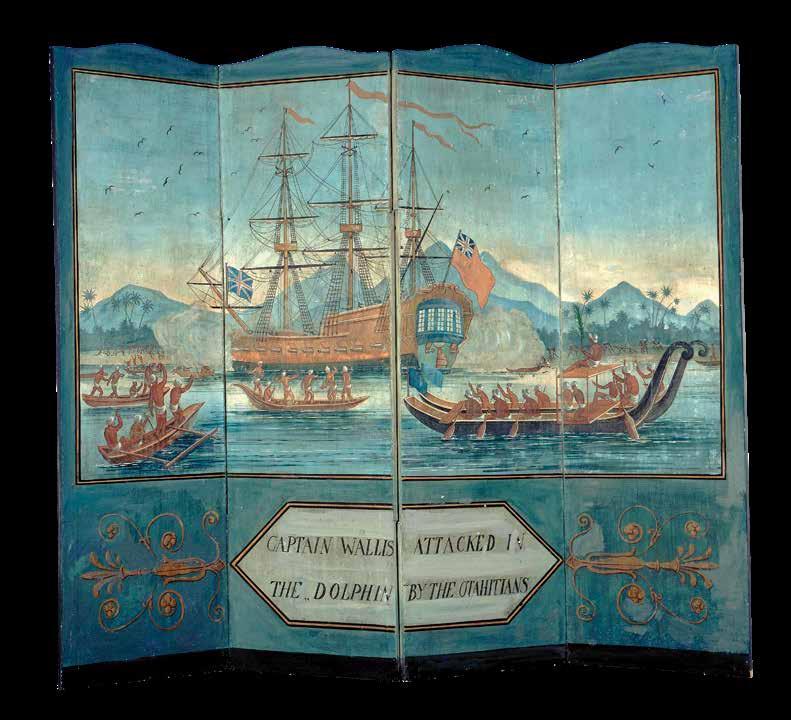

SIGNALS 89 DECEMBER 2009–FEBRUARY 2010 13

The artistry of such skilfully carved pieces can distract the observer from the violence that occurred in many encounters between Europeans and indigenous peoples in the Pacific
opposite:
Soon after his arrival, Omai was presented to the King and Queen. He became a favourite of both ‘polite society’ and scientific circles, dining with the Royal Society and botanising with Joseph Banks. He visited the Earl of Sandwich at his Hinchingbrooke country house and while in London regularly attended the opera and theatre. His elegant manners and dress impressed all – as Joseph Banks’s accounting books show, he ran up considerable tailors’ bills at the famous botanist’s expense.
Omai was sketched by Joshua Reynolds (a work held at the National Gallery of Australia, Canberra) in a study for a larger portrait painted in 1775 or 1776. The portrait, showing Omai dressed ‘in the habit of his country’, has been regarded as one of Reynolds’ finest and an important example of 18th-century British art. Another important depiction is Omai, a native of Ulaietea, the engraving by Francesco Bartolozzi (1727–1815) after a painting by Nathaniel Dance commissioned by the Earl of Sandwich in 1774. The example in this museum’s collection is reproduced at left. It shows Omai clothed in tapa cloth, holding his neck rest, a bag and a feather ‘whisk’. These and other images of Omai widely increased his currency as the classic representation of the ‘noble savage’. By 1776 public interest in Omai as a celebrity had begun to wane. His wealthy benefactors had taught him little else besides how to behave like a ‘gentleman’ – which mainly involved dressing for the theatre, polite manners and of course, how to play card games.
above: Omai, a native of Ulaietea, engraving by Francesco Bartolozzi (1727–1815) after a painting by Nathaniel Dance. Omai is clothed in tapa cloth, holding a bag, a feather ‘whisk’ and a neck rest used as a pillow to prevent disturbance of elaborate hairstyles. ANMM collection.
Curator Dr Nigel Erskine and conservator Kathryn Yeates examine the newly acquired artefacts. Photographer A Frolows/ANMM
SIGNALS 89 DECEMBER 2009–FEBRUARY 2010 14

Sailing for home, Omai embarked upon Cook’s third voyage well-supplied with gifts that included various livestock, a ‘jack-in-the-box’, fireworks and some muskets, powder and shot.
Cook spent a deal of energy resettling Omai in Huahine. He negotiated with the ari’i or principal chiefs of Huahine for land for Omai to keep his horses, goats and other European ‘trinkets’, and had a house built for him. Omai’s arrival on Huahine was crafted to impress. According to Lieutenant John Rickman’s journal, he appeared on horseback alongside Cook, dressed in a suit of armour provided for him by the Earl of Sandwich. As they rode in ‘triumph’, Omai fired his pistols whenever the crowding islanders ‘became clamorous’.
Sadly, Omai’s life in his homeland was short and when William Bligh arrived in the islands aboard the Bounty in 1788, he found that Omai had died in 1779.
Tobias Furneaux seems not to have collected artefacts extensively. After some pieces were given by the Furneaux family to the Lords of the Admiralty and the Royal Society (now in the British Museum), the family kept a small group of objects including the Maori patu, the two Tongan akua-ta, and a ‘Tahitian stool’ (in fact a neck rest) at their family home at Swilly, near Portsmouth. The neck rest is seen under Omai’s arm in the famous Bartolozzi engraving in the museum’s collection. The objects remained there until the house was demolished in the 1920s. In 1986, Furneaux descendants offered the group of objects for sale.
Omai’s famous neck rest was purchased by the Musee de Tahiti et des Iles while the other objects were bought by a private collector in Australia. It is this remnant of the collection held by Furneaux and his heirs that the museum has acquired.
These three Polynesian weapons that have come to be associated with the name of Omai, and that returned with Furneaux to England after his important role in Cook’s second circumnavigation, are some of the most important objects acquired by the museum. Rarely does a set of 18th-century Pacific objects with such extraordinary provenance become available. The richly decorated akua-ta and the patu will join the museum’s image of Omai on display in the Navigators exhibition. They will add depth to the museum’s collections relating to Cook, the European exploration of the Pacific and the interaction between Europeans and the Indigenous people of Australia and the Pacific islands. The museum’s focus on James Cook and his expeditions has been a particular strength over a long period of time. The sternpost of HMS Resolution was a very early acquisition, and a museum team has been actively involved in the search for remains of the original Endeavour on the floor of Newport Harbor in Rhode Island, USA, since the 1990s. The more recent addition to the museum’s assets of the acclaimed replica of HM Bark Endeavour – open here as a floating museum for a large part of each year but also voyaging regularly to other ports on the Australian coast – has added significantly to this.
Further reading
Beaglehole, J C (ed), The Journals of Captain James Cook, II The Voyage of the Resolution and Adventure 1772–1775 The Boydell Press in arrangement with the Halkuyt Society, Suffolk, 1999
Christies: ‘The Omai Relics, in the sale of Tribal Art at Christie’s South Kensington, London, 23 June 1986’ Christies, London, 1986
Furneaux, R, Tobias Furneaux: Circumnavigator Cassell, London, 1960
Hauser-Schaublin, A and Kruger, G, (eds) James Cook: Gifts and Treasures from the South Seas. The Cook/Foster Collection Prestel, Munich, 1998
Hetherington, M, McCalman, I and Cook, A (eds), Cook and Omai: The Cult of the South Seas National Library of Australia in association with the Humanities Research Centre, The Australian National University, Canberra, 2001
Hooper, S, Pacific Encounters: Art and Divinity in Polynesia 1760–1860 The British Museum Press, London, 2006
Kaeppler, A L, Artificial Curiosities: An exposition of Native Manufactures Collected on the Three Pacific Voyages of Captain James Cook, R N Bishop Museum, Honolulu, 1978
SIGNALS 89 DECEMBER 2009–FEBRUARY 2010 15
During an internship at the museum, historian Dave Earl researched and documented the armaments in the National Maritime Collection. He writes here about weapons that were associated with Australia’s military involvement in the Boxer uprising in China during the early 20th century.
Weapons of the
There was a particularly large European presence in the coastal province of Shandong, and it was here that disaffected Chinese residents formed a secret society aimed at cleansing China of foreign influences. Calling themselves the ‘Society of Righteous and Harmonious Fists’, members became known in the Western press as ‘Boxers’.
In June 1900 the Boxers, having gained widespread popular support in northern China, attacked Western outposts in the cities of Beijing and Tianjin. Within days, the Chinese government offered its support for the rebels, and declared war on all foreign powers. Western traders in several Chinese cities found themselves besieged.
In 2008 and 2009, as part of an internship at the museum, I was asked to research the histories of the small arms in the museum’s collection. The museum holds around a dozen swords, two dozen firearms, and a handful of assorted weapons including pikes, dirks, axes, and a walking-stick rumoured (but not yet proven) to conceal a blade. Of these, six are associated with the Australian contingent sent to China in 1900.
A booming trade in primary resources, a Prime Minister fluent in Mandarin, Chinese-manufactured computers, televisions and iPods everywhere you look – it seems that today Australia is more and more engaged with China. It’s easy to forget that our trade relations with the Chinese go back to the earliest colonial times. Although 19th-century Australian consumers had different tastes from ours, their appetite for products from China was just as insatiable. Chinese silk, porcelain and tea were among the products regularly imported into Britain’s antipodean colonies.
Trade relations between China and Britain were not always smooth, however. For centuries, the Chinese empire had imposed heavy restrictions on foreign trade, and open warfare – notably the Opium Wars of the mid-19th century –occurred between the two powers. By the turn of the 20th century, Britain, as well as several other Western nations, had forced numerous concessions on China. The balance of trade had shifted heavily in favour of the West, and many Chinese felt shamed and humiliated by the European presence in their major cities.
In response, European and Japanese forces combined to form the Eight Nation Alliance, consisting of Britain, France, the United States, Russia, Germany, Italy, Austria-Hungary and Japan. Together, they sent over 20,000 troops to China in an attempt to quell the uprising. The Australian colonies, keen to offer their support, assembled a contingent of almost 500 men to send to China as part of this larger force. With Australia’s ground troops already engaged in the Boer War, the colonial governments turned to their naval brigades. Made up of part-time volunteers, these brigades were intended to defend major harbours in the event of invasion. Their deployment in China was the first and only time the naval brigades would be called upon to provide land service overseas.
Since this was a naval enterprise, the Australian National Maritime Museum holds a significant collection of items relating to the campaign.
The history of the naval brigades is not so widely known. In the early 19th century, the Australian colonies were officially defended by the Royal Navy and the British Army. However, with the French annexation of New Caledonia in 1853, and the outbreak of the Crimean War between Britain and Russia the following year, colonial Australia began to organise its own local forces. These usually took the form of volunteer militia whose members met informally on weekends to practice target shooting, marching and drill. By the 1860s, most

SIGNALS 89 DECEMBER 2009–FEBRUARY 2010 16
Boxer uprising

Firearms of the naval brigades: an obsolete muzzleloading pistol; a slightly less obsolete single-shot .577 calibre Martini Henry rifle; and a bolt-action, magazine-loaded Mannlicher rifle that was probably obtained as a souvenir. ANMM collection

SIGNALS 89 DECEMBER 2009–FEBRUARY 2010 17
Members of the
‘Society of Righteous and Harmonious Fists’ were known in the Western press as ‘Boxers’
had imagined, the volunteers spent the bulk of their tour undertaking garrison duty in Beijing and Tianjin, a task that primarily involved policing and fire patrolling. The force suffered a total of six casualties – all from illness or misadventure.
major centres had at least one voluntary rifle corps or brigade. Port Phillip and Sydney Harbour were both protected by naval brigades founded around this time.
The Victorian Naval Brigade was formed in 1859, and by the 1890s comprised several hundred members divided into two divisions, one based in Williamstown and the other at Sandridge. From 1867, the Victorian brigade was supplemented by a small professional navy, with a fleet of several vessels. Most of these, however, required brigade crew to make up a full complement. The New South Wales Naval Brigade was founded in 1864. By the turn of the 20th century, its members numbered over 600, including a Newcastle contingent. They too had several vessels, although by 1900 these were widely regarded as obsolete.
Though many members of both brigades were ex-Royal Navy men, they met infrequently and their voluntary nature led some to conclude that they were more a social club than a serious means of defending the colonies.
The press reported their exercises wryly. One commentator described the New South Wales Naval Brigade in disparaging terms in 1882:
… they rarely, if ever, drill in daylight, and have never exercised afloat. The force, at present, is of no value for service afloat, and is not really a naval brigade.
Still, the Colonies were keen to contribute to the efforts in China, and the naval brigades were the best they had in the circumstances. In July 1900, almost 200 Victorian volunteers steamed to Sydney on the liner SS Salamis Once there, they collected the New South Wales force, comprising around 250 volunteers and 20 officers. In early August, the Salamis departed for China. Unfortunately for the eager volunteers, most of the fighting was over by the time they arrived the following month. Rather than engaging in the glorious battles they
The contingent steamed back to Sydney in March 1901. There, a member of the New South Wales Brigade was thought to be carrying smallpox, and the entire force was required to spend a month in quarantine. Finally, in May, the Victorian members returned home to Melbourne by train, where a tickertape parade awaited them.
Quite a few members of the contingent found their overseas adventure rather disappointing. Others, however, looked back on it with fondness, and many retained mementoes of their time in China. Souveniring is a fairly common practice among members of armed forces on foreign service. Several of the weapons in the collection associated with the Boxer uprising are thought to be souvenirs, collected from allied contingents or from the Boxers themselves. Others, such as a Martini-Henry rifle, are decorated and inscribed in memory of the expedition.
The single-shot, .577 calibre MartiniHenry was one of the most commonly used rifles in the British Empire during the late 19th century. Its breech-loading mechanism, which allowed metal cartridges to be quickly loaded and fired, was a significant improvement on earlier rifles, and from the 1870s it was standard issue in the British Army. Produced in vast quantities by several manufacturers, the rifle was used by troops in all the Australian colonies. The museum holds two of these weapons, both associated with the Boxer uprising.
By the start of the 20th century, however, these rifles were considered fairly old-fashioned. Box-magazine rifles such as the .303 Lee-Enfield, which allowed faster loading of ammunition, had been phased in as army standard. The naval brigades, chronically under-funded, retained the older Martini-Henrys.
An officer complained in early 1900:
We can’t equip a single man. We have not even a water bottle, nor have we any haversacks for the men. As regards our arms, the machine guns are obsolete; we have only the old-pattern Martini-Henry rifles, and in fact no field kit of any description could be taken to the front.
The first Martini-Henry held by the museum was manufactured by the Birmingham Small Arms Company
in 1885. It is a Mark III version of the rifle, one of the most widely used variants. Markings on its stock reading ‘NSWSB NB 127’ indicate that it was issued by the New South Wales Naval Brigade, and several ‘UNSERVICABLE’ stamps suggest that it may have been sold for private use after the brigade had finished with it – a common occurrence.
The museum’s other Martini-Henry from the Boxer uprising is perhaps more interesting. It too is a Mark III, but manufactured by the London Small Arms Company. The rifle was owned by J C Jamieson, a Leading Stoker in the Victorian Naval Brigade. I have been unable to find a great deal of biographical information on Jamieson, but we do know that he travelled with the naval brigade to China in 1900. Although it is standard issue, Jamieson’s rifle features a unique customisation: presumably while in China, Jamieson had the rifle’s stock engraved with several Chinese characters and an ornate ‘dragon chasing pearl’ motif. Traditionally the dragon is believed to represent strength and goodness (see the section on dragons in the article ‘Mythic Creatures’ on page 7). It is often said to symbolise the Emperor or even China itself. The pearl stands for wisdom and its pursuit by the dragon indicates the latter’s constant search for knowledge and sound judgement.
Less decorative, but similarly intriguing, is a rifle described in the museum’s catalogue simply as ‘a souvenir from the Boxer rebellion’. The rifle has no distinct maker’s marks, but features what is possibly a serial number: ‘51006’. I was initially stumped as to the gun’s background, but eventually it emerged that the rifle is an Austro-Hungarian model 1888 Mannlicher. These were produced in huge numbers, and were standard Austro-Hungarian military issue until the end of Word War I. It is likely that its Australian owner collected it from a member of the Austro-Hungarian contingent before returning to Australia. Compared to the naval brigades’ MartiniHenrys, this was at the time a cutting-edge piece of weapons technology.
top: Aberdeen Line passenger ship SS Salamis departing Sydney on 8 August 1900 with members of the Australian contingent to the Boxer uprising in China. Watercolour by J D Castle (1858–1928) ANMM collection
bottom: The band of HMVS Cerberus – pride of the Victorian Naval Brigade – in 1898. Chief Petty Officer Walter Underwood, owner of the muzzle-loading pistol discussed here, is leaning his elbow on the bass drum at the centre-right. Reproduced courtesy of Australian War Memorial, AWM 305343
SIGNALS 89 DECEMBER 2009–FEBRUARY 2010 18


SIGNALS 89 DECEMBER 2009–FEBRUARY 2010 19
Of more certain provenance, but far from cutting edge, is a hefty, double-barrelled, muzzle-loading percussion-cap pistol owned by 1st Class Chief Petty Officer Walter Underwood of the Victorian Naval Brigade contingent to China. Introduced in the 1830s, the percussion lock utilised a cup-shaped metal cap filled with a shock-sensitive explosive material. This was placed over a nipple leading to the breech chamber where the gunpowder and ball were located. When the weapon’s hammer struck the cap, the resulting flash ignited the gunpowder. This system allowed for greater all-weather reliability than the earlier, more complex flintlock mechanism. Most military forces had phased out percussion-lock muzzle loaders well before the end of the 19th century, and by 1901 it would have been considered a curiosity.
The pistol is marked ‘Kynock & Co, Birmingham’. It is also stamped ‘TOWER 1867’, which correlates with its likely year of manufacture. It may have been produced as a naval boarding weapon. In commemoration of the Chinese campaign, the pistol is marked ‘W U C E F 1901’: Walter Underwood, China Expeditionary Force. But what was Underwood doing with such an old-fashioned firearm? It is possible that he collected this weapon from a Boxer, many of whom were badly armed or unarmed altogether. However, other weapons associated with the Victorian Naval Brigade feature similar ‘TOWER’ markings. If Underwood brought the

weapon with him to China, it is a good indication of how poorly equipped the expedition really was.
Bladed weapons such as swords and dirks were also outdated by the beginning of the 20th century, but they retained an important ceremonial purpose. Naval officers usually carried swords when landed; they were a significant symbol of authority and were often richly decorated examples of the sword-smith’s craft. One of the most impressive weapons in the museum’s collection is a naval officer’s sword used by Lieutenant William Staunton Spain of the New South Wales Naval Brigade. Spain commanded the contingent’s D-Company during the uprising. The museum holds numerous items belonging to Spain, including his epaulettes and their storage case, a bicorn hat, and a pith helmet he wore during the Chinese campaign.
Spain’s sword was dispensed by the London cutlers Firmin and Sons, and its half-basket hilt features an elaborate fouled anchor motif common on British naval swords. The blade is etched with intricate floral decorations, one side features another fouled anchor framed by a crown and starburst. The obverse displays a larger crown and the text ‘NB NSW’, giving the sword a rare confirmation of its association with these early naval brigades.
A midshipman’s dirk, also from the New South Wales Naval Brigade, features similar intricate detail. Far shorter than officers’ swords, the midshipman’s dirk
Rather than engaging in glorious battles, the volunteers spent the bulk of their tour undertaking garrison duty
was first introduced by the Royal Navy in 1856. The naval brigades, which mimicked official naval attire, adopted them for ceremonial occasions. It is not known how regularly these dirks were issued: one historian has observed that in an 1897 photograph of the NSW Naval Defence Force (consisting of the Naval Brigade and the Naval Artillery Volunteers), only three of eight midshipmen wore dirks.
Perhaps because of this, dirks associated with the New South Wales Naval Brigade are particularly rare. Only six examples are known to survive, and of these, just three are etched with naval brigade insignia. The museum’s example is particularly fine. It features a silvered blade with decorative inlaid engraving on either side, predominately floral motifs similar to those on Lieutenant Spain’s officer’s sword. On the left side of the blade, ‘Royal Naval Brigade NSW’ is contained within a scroll, and once again, a fouled anchor features prominently on the hilt.
Several of these weapons, along with other Boxer uprising memorabilia, are on display in the museum’s Navy exhibition. Author Dave Earl’s research on these six weapons, as well as on the museum’s other small arms, will gradually be made available on the eMuseum website http://203.35.183.199/eMuseum/code/ emuseum.asp, or you can read more on the museum blog http://anmm.wordpress.com/ category/curiouser-and-curiouser/.
Researcher Dave Earl examines weapons from the National Maritime Collection that are associated with the Australian contingent sent to the Boxer uprising. Photography A Frolows/ANMM
SIGNALS 89 DECEMBER 2009–FEBRUARY 2010 20
Members
News
Exclusive! Members can sail on our historic vessels during Fleet Week –the scheduled sailing days when the vessels are taken out on the harbour and put through their paces. Members are shown here on board our veteran of the first Sydney-Hobart race in 1945, the gaff ketch Kathleen Gillett. Contact the Members office for information about joining us on board!
Photographer Member Bronwyn Gault

Grey Sydney weather didn’t dampen spirits on our Members cruise on Port Hacking where we enjoyed lunch in Bundeena and a bushwalk in the Royal National Park while learning about explorers, historic settlements and sacred Aboriginal sites. L to R: Members Laurie and Lois Larcombe, Jan Coulter; heritage ferry Kurrunulla
Photographer Claire Palmer/ANMM
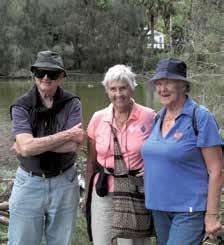
Mermaids and merriment
We’re getting ready for the huge international exhibition Mythic Creatures: Dragons, Unicorns & Mermaids, organised by the American Museum of Natural History, New York, and opening on 19 December. Read all about it in the opening pages of this edition of your Members magazine Signals This one promises to be a really enjoyable experience for the whole family so why not plan to make a day of it here in the holiday period? We have a host of activities relating to this exhibition including a museum sleep-over.
With the summer holidays approaching, there will be lots more happening for your children from 27 December until 24 January. They can splash into Wetworld – just be prepared for them to get wet! Our activity centre Kids on Deck has lots of fun and mythic-critter craft-making for the young ones, and a puppet theatre program runs weekdays. Visit our website for more holiday programs.
Looking for that last-minute Christmas gift? Why not purchase a museum membership – it lasts all year and is a great gift idea for friends or family. We can send direct to the recipient with a gift card in a matter of days. Simply contact the Members Office to arrange but please order Xmas gift memberships no later than 23 December.
Our popular Boxing Day Sydney-Hobart cruise on board MV Seivadis is always fun, a great follow-up to Christmas that puts us right up there as the race fleet charges out of Sydney Heads. Once again we are
organising our annual family cruise on board Captain Cook II on Australia Day to take in all the on-water activities that Sydney Harbour offers. And if getting out on the water is for you, the Endeavour replica’s sailing program starts again in April 2010. This will include some overnight and halfday sails and some exciting longer offshore voyages. Members of course receive a discount and bookings will open shortly.
Don’t forget to pop into the Members Lounge whenever you visit for a welcoming complimentary tea, coffee or cordial for the kids. The Lounge is located near the Navy exhibition and if you visit during December you will get a sweet Christmas treat! For something a little more filling, you can’t beat a meal or glass of wine by the water at Yots Café, great food and great value and don’t forget your Members 10% discount.
You will notice that from 1 January membership fees will increase ever so slightly to take into account rising costs. You might also have noticed recent changes to our website with a new look and more ways to become involved with the museum. If you have any suggestions or feedback about any of this, do contact the Members office.
Thank you for your continued support throughout the year and I look forward to seeing you at the museum in 2010. With Christmas just around the corner, on behalf of us all in Members, please have a safe and happy Christmas and a terrific New Year.
Adrian Adam, Members manager

SIGNALS 89 DECEMBER 2009–FEBRUARY 2010 21
Members events
Calendar Summer 2009
Sunday 13 Special: Champagne shopping & kids tour
Thursday 17 Tour: Goat Island
Saturday 26 On the water: Sydney–Hobart race-start cruise
Thursday 7 For kids: Wetworld family breakfast (Mermaids & Waterdragons)
Thursday 14–15 For kids: Mythic museum sleepover – Night-time critters
Tuesday 26 Australia Day: Family ferry cruise
Tuesday 26 Australia Day: HMB Endeavour replica sail
Tuesday 26 Australia Day: Family fireworks & picnic
Friday 5 Lunchtime curator tours: Mythic Creatures
Sunday 7 Lecture: Captain Cook and the Omai Relics
Friday 12–13 For kids: HMB Endeavour sleepover – Tall ship tales
Sunday 14 Talk: Ships Belles: Women in the RAN
Friday 19 For the family: Spotlight Creatures with Warren Fahey
Saturday 20 On the water: Middle Head harbour cruise
Sunday 28 Special: Yum-cha dragon-boat lunch March
Friday 5 Lunchtime curator tours: Mythic Creatures
Wednesday 10 Preview: Maritime Cambodia tour – illustrated talk
Thursday 11 Lecture: 8th Phil Renouf Memorial Lecture
Booked out?
It’s only takes a phone call to book for these Members events … have a credit card ready and we can take care of payments on the spot.
• To reserve tickets contact the Members office: phone 02 9298 3644 (business hours) or email members@anmm.gov.au Bookings strictly in order of receipt.
• If phoning, have credit card details handy.
• If paying by mail after making a reservation, please include a completed booking form with a cheque made out to the Australian National Maritime Museum.
• The booking form is on reverse of the address sheet with your Signals mailout.
• If payment is not received seven days before the event your booking may be cancelled.
We always try to repeat the event in another program.
Cancellations
If you can’t attend a booked event, please notify us at least five days before the function for a refund. Otherwise, we regret a refund cannot be made. Events and dates are correct at the time of printing but these may vary … if so, we’ll be sure to inform you.
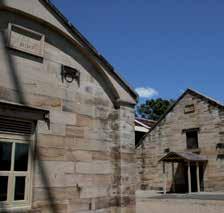
Christmas special Champagne shopping & kids tour
5.30–7 pm Sunday 13 December
Complimentary champagne and 20% discount at The Store. Our exhibitions open late for you to wander. Send your kids on the Merritime Museum Message in a Bottle Christmas tour with Stormy Grey the Stowaway – free gift for every child. Free for Members. RSVP for 6 pm kids tour
Tour
Goat Island
10 am–12.30 pm Thursday 17 December
Discover Goat Island’s Indigenous, convict and maritime history and hear tales of crime, punishment and escape. A convict-built explosives store during the 19th century, the island later served as a water police station, and then as a depot for Sydney Harbour’s maritime operations. Closed for the past four years, here’s your chance to delve into its history and see recently completed improvements on a private tour with island ranger Rob Newton.
Members: adults $30, child $20. Guests: $40, child $30. Meet at the Heritage Pontoon next to submarine Onslow
On the water
Sydney–Hobart race-start cruise
11 am–2.30 pm Saturday 26 December
Farewell this year’s Sydney-Hobart fleet on board luxury ferry MV Seivadis. Take in the colour, excitement and salt spray of our harbour’s bluest blue-ribbon day. Picnic on your leftover Christmas dinner as we follow the fleet to the heads.
Members: adult $60, child $30. Guests: adult $70, child $40. BYO picnic. Cash bar on board. Meet next to submarine
How to book
Parking Wilson
offers Members discount parking
nearby Harbourside Carpark, Murray Street, Darling Harbour.
obtain
discount,
must have
ticket
at
museum
desk.
Parking
at
To
a
you
your
validated
the
ticket
December
January
February
SIGNALS 89 DECEMBER 2009–FEBRUARY 2010 22
Goat Island



For kids
Wetworld family breakfast: Mermaids and waterdragons
8.30–10 am Thursday 7 January in Wetworld
Meet Ariel the Mermaid and splash about in Wetworld, our interactive water-based space! Learn how to sing, dance and act like a mermaid. Grab your swimmers and be prepared to get wet! Wetworld fun includes the Super Soaker Action Zone, a chance to make amazing bubbles, our radio-controlled boats (sponsored by Waterways), and much more. And we’ll kick off with a champagne for parents or carers!
Members (adults and children) $15, guests $20. Includes light refreshment
For kids
Mythic museum sleepover: Night-time critters and sleeping beasts
6.30 pm–9.30 am Thursday 14–Friday 15 January at the museum
Come dressed as a dragon, unicorn, mermaid or mythical monster for a wild rumpus overnight at the museum! See mythical creatures come to life on a torchlight tour through the Mythic Creatures exhibition. Enjoy lots of fun activities, mythic films and a sleepover in the Tasman Light.
For children 5–12 years (must be accompanied by an adult).
Members $85, guests $100. Includes dinner and BBQ breakfast
Australia Day
Family ferry cruise
10.30 am–2.30 pm Tuesday 26 January on the harbour
Enjoy Australia Day harbour festivities on MV Captain Cook II. Get stirred up in the wash of the famous Ferrython, the spectator fleet, the tall ships, Navy and Air Force flyovers, and lots more.
Members: adult $50, child $30, family of 4 $140. Guests: adult $65, child $45, family of 4 $160. BYO picnic, cash bar on board. Meet at Harbourside South Steps near Manly ferry South Steyne
Australia Day
HM Bark Endeavour sail
11 am–3 pm* Tuesday 26 January on the harbour
Enjoy a great day out on HM Bark Endeavour replica and take in all the fun and excitement of the Australia Day festivities on the harbour. Be a part of the spectator fleet, compete in the Tall Ships race, enjoy live music and lots more.
* Departure time to be confirmed at booking. Members $165, guests $185. Includes gourmet lunch, afternoon tea and Coral Sea wine. Meet next to Endeavour gangway at the museum
Australia Day
Family fireworks & BYO picnic
7–10 pm Tuesday 26 January museum forecourt and Vampire decks
Celebrate Australia’s national day and watch the magnificent Darling Harbour fireworks at our family-friendly location, with entertainment by our roving jazz band. Fireworks at 9 pm in Cockle Bay can be viewed from all areas of the museum forecourt and Vampire. BYO picnic dinner and we’ll provide chairs, face-painting – and a great view! Rain, hail or moonshine.
Members: adults $15, child (16 and under) $10, family of 4 $40. Guests: adults $20, child $15, family of 4 $55. Snacks, coffee and refreshments on sale
Lunchtime curator tours
Mythic Creatures: Dragons, Unicorns & Mermaids
12 noon and 1.30 pm Friday 5 February at the museum
Enjoy a tour of our Mythic Creatures exhibition with a museum curator. See our larger-than-life models of a dragon, a unicorn, a swooping giant Roc and an enormous multi-tentacled sea-monster. View life-size recreations of extinct beasts that might have inspired tales of strange and fantastic mythical creatures.
Members $15, guests $20. Includes light lunch and Coral Sea wine.
Sleepover at the museum
Australia Day family ferry cruise
SIGNALS 89 DECEMBER 2009–FEBRUARY 2010 23
Mythic Creatures: Dragons, Unicorns & Mermaids
Members events

Lecture
Award-winning book Captain Cook: Voyager Between Worlds and the ‘Omai relics’
3–5 pm Sunday 7 February at the museum
Cook’s Pacific voyages represent the meeting of two very different cultures: the late 18th-century England of Cook and his crew, and the world of the peoples of the South Pacific. Meet Professor John Gascoigne (History Department, University of New South Wales), author of Captain Cook: Voyager Between Worlds, winner of the 2009 Frank Broeze Memorial Maritime History Book Prize administered by this museum. Senior curator Dr Nigel Erskine will then speak about the ‘Omai relics’ – two carved wooden clubs and a whalebone cleaver collected from Polynesian communities on Cook’s second voyage (1772–75) – see story page 10.
Members $15, guests $20. Includes Coral Sea wine and cheese on board HM Bartk Endeavour replica
BOOKINGS AND ENQUIRIES
Booking form on reverse of mailing address sheet:
phone 02 9298 3644 fax 02 9298 3660 (unless otherwise indicated). All details are correct at time of publication but subject to change.

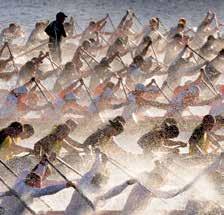
For kids
HMB Endeavour sleepover: Tall ship tales
6.30 pm–9.30 am
Friday 12–Saturday 13 February on board Endeavour replica
Hear mythic tales from the sea under the stars on the deck of HMB Endeavour and spend a night onboard the ship berthed alongside the museum.
For children 8+ years (must be accompanied by an adult).
Members $120, guests $130. Includes dinner and BBQ breakfast
For the family
Spotlight creatures of the Aussie bush
6.15–8.30 pm Friday 19 February at Centennial Park
Yowies, bunyips and creatures that go bump in the night! Listen to spine-tingling tales and wacky songs of creatures that inhabit the Australian bush with local larrikin and folklore raconteur, Warren Fahey am. Bring a picnic and enjoy a twilight concert in Centennial Park. Then spot possums, flying foxes and other mysterious night creatures with a Ranger guide. Bring a torch.
Members: child $15, adult $20, family (2 adults, 2 children) $65.
General: child $20, adult $25, family $75. Meet at Robertson Road gates
On the water
Mosman Peninsula and Middle Harbour cruise
10 am–2 pm Saturday 20 February on the harbour
Enjoy a leisurely cruise to Middle Harbour where we’ll see private beaches and secluded bays. Admire popular locations such as Balmoral Beach, Taylors Bay and Chinaman’s Beach, and sail under the famous Spit Bridge. Dianne McKrummel from Mosman Historical Society and Sydney Heritage Fleet will give an insight into the history of the Mosman Peninsula and Middle Harbour.
Members $55, guests $65. Includes light lunch and refreshments. Meet at the heritage pontoon next to submarine Onslow
Special
Yum-cha dragon-boat lunch
12.30–2.30 pm Sunday 28 February Port Orient Restaurant, Harbourside Darling Harbour
Experience the excitement, colour and thrill of dragon-boat racing, as you enjoy a delicious yum-cha lunch overlooking Darling Harbour. Hear about the 2,000-year history of this tradition from a representative of Dragon Boats NSW, and learn about the origin and folklore of the legendary Asian dragon from expert in Chinese thought, philosophy and culture, Dr Shirley Chan (Macquarie University).
Members, $55; general, $65. Includes lunch and a champagne on arrival. Bookings 9298 2644
Captain Cook: Voyager Between Worlds
HMB Endeavour sleepover: Tall ship tales Yum-cha dragon-boat lunch
SIGNALS 89 DECEMBER 2009–FEBRUARY 2010 24

Talk
Ships Belles: Women in the RAN, the road to command at sea
3–5 pm Sunday 14 February at the museum
Hear about the vital contribution of women in the naval services, from the earliest days of The Women’s Royal Australian Naval Service – affectionately known as the WRANS – to the women who have taken command at sea today. Speakers include Shirley Fenton-Hui, former WRAN and author of Ships Belles: The story of WRANS in war and peace 1941–1985; PCHA Gareth Clayton ran (rtd), former Naval Chaplain and Patron of the Sydney WRANS; and Commander Allison Norris ran, one of the Navy’s highest ranking female officers, who took command of HMAS Melbourne in 2008.
Members $15, guests $20. Includes afternoon tea and refreshments on board HMAS Vampire
EMAIL BULLETINS
Have you subscribed to our email bulletins yet?
Email your address to members@ anmm.gov.au to ensure that you’ll always be advised of activities organised at short notice in response to special opportunities.


Lunchtime curator tours
Mythic Creatures: Dragons, Unicorns & Mermaids
12 noon and 1.30 pm Friday 5 March at the museum
Enjoy a tour of our Mythic Creatures exhibition with a museum curator. See larger-than-life models of a dragon, a unicorn, a swooping giant Roc and an enormous multi-tentacled sea-monster. View life-size reconstructions of extinct beasts that might have inspired tales of strange and fantastic mythical creatures.
Members $15, guests $20.
Includes a light lunch and Coral Sea wine
8th Phil Renouf Memorial Lecture ‘Young men mucking about in old boats’
6.15–8.30 pm Thursday 11 March at the museum
The museum and Sydney Heritage Fleet join forces again to present the annual lecture in honour of the late president of SHF, Phil Renouf. This year’s speaker is Warwick Turner, one of the founders of the Sydney Heritage Fleet, who was instrumental in saving and restoring the Lady Hopetoun back in the 1960s. Warwick has had a lifelong passion and interest in steam vessels and their restoration, in particular the inland paddle-steamers of previous centuries. He will speak about his fascinating background, some of the classic steam vessels that have caught his eye over the years, and the way forward in understanding and preserving our maritime heritage.
ANMM and SHF Members $20, guests $25. Includes Coral Sea wine and cheese
Exclusive overseas adventure
The floating world of Cambodia 19 November 2010–5 December 2010 $4,090 per person including airfares
Tour preview and illustrated talk
6.30 pm Wednesday 10 March at the museum
Join us in 2010 to explore the magnificent temples of Angkor and discover Cambodian maritime traditions – ancient and modern – on the museum’s latest Asian cultural adventure. On this 17-day tour our guests will gain insights into the unique marine environment that supported the great Khmer empire and its unrivalled monuments – including world-renowned Angkor Wat – while experiencing Cambodian life as it’s lived today on its inland waterways and sea coasts. This exclusive tour developed in conjunction with World Expeditions is led by museum staff member and Asian specialist Jeffrey Mellefont, leader of our previous maritime-culture tours of Indonesia and southern India. See pages 32–33 for more details.
Price $4,090 includes airfares and airline taxes, twin-share hotel and breakfasts, transfers and transport, entry to sites, guides. Travel insurance, single supplement ($385), Cambodian visa not included in the package price. Detailed trip notes at www.anmm.gov.au/membersevents.
For preview 6.30 pm 10 March 2010 call Members office on 02 9298 3644. For more information and bookings call Kate or Fiona at World Expeditions (02) 8270 8400, toll free 1300 720 000 or email info@worldexpeditions.com.au.
Ships Belles: Women in the RAN
Mythic Creatures: Dragons, Unicorns & Mermaids Angkor Wat, Cambodia
SIGNALS 89 DECEMBER 2009–FEBRUARY 2010 25
What’s on summer 2009/10 Events



International Day of People with Disability Flags Ahoy!
Tuesday 1–Thursday 31 December
Celebrating International Day of People With Disability, the museum will be flying the colours of artworks painted on flags by members of community and disability groups from around New South Wales.
Submarine tours for people with vision impairment
11 am Sunday 6 and Monday 7 December
Celebrating the 40th anniversary of the commissioning of HMAS Onslow, free guided tours of our Oberon class submarine, specifically designed for people with vision impairment.
Morning tea provided. Friends and family welcome. Bookings essential 9298 3777 or email events@anmm.gov.au
An encounter with Endeavour
5.30–8 pm Wednesday 17 February & Wednesday 17 March
View the ship accompanied by Endeavour master Ross Mattson who will guide you through the intricacies of steering and navigating this historic vessel. Teacher-guide John Lamzies will describe day-to-day life and historic goings-on in the Great Cabin. A hot supper will be served below in the Modern Mess Deck.
$25 (Members $20).
Bookings essential 9298 3655
Program times and venues are correct at time of going to press. To check programs before your museum visit call 02 9298 3777.
Mythic creatures in science, art and literature
10 am–2 pm Thursday 25 February
Mythic creatures feature in the stories, art and belief systems of most cultures, but they are not entirely figments of the imagination. Hear palaeontologist Robert Jones (Australian Museum) on dinosaur fossils that inspired the ancients; Dr Alastair Blanshard (University of Sydney) on monsters in the classics; Dr Bernadette Masters on mythical beasts in mediaeval art and literature; and Dr Khanh Trinh (Art Gallery of New South Wales) on the symbolism of the dragon in East Asian art. Stroll to the Chinese Gardens to see some of these symbols then return to view Mythic Creatures
$39. Includes morning tea.
Bookings essential WEA 9267 6988
Touch tour of Mythic Creatures
11 am Sunday 28 February
Join our guides for a touch tour of the exhibition Mythic Creatures: Dragons, Unicorns & Mermaids for people with vision impairment.
Complimentary morning tea provided. Friends and family welcome.
Bookings essential 9298 3777 or email events@anmm.gov.au
Cruise Forum 1
Pearling and whaling: buttons, baleen and blubber
10 am–2 pm Wednesday 3 March
Listen to writers John and Verity Norman ( A Pearling Master’s Journey) as they recount a history of the pearling industry in Western Australia. Then author Robert Holden (The Devil and the Deep Blue Sea) will bring alive all the drama, danger and adventure of the whaling industry.
View whaling sites on Sydney Harbour from a heritage ferry and picnic at Chowder Bay (now Clifton Gardens). On return inspect the museum’s pearling lugger John Louis $60 (Members $55).
Includes cruise and lunch.
Bookings essential WEA 9267 6988
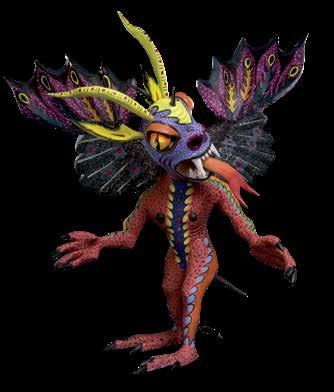 Submarine tours for people with vision impairment
Submarine tours for people with vision impairment
Far left: Submarine HMAS Onslow , photo RAN. Centre: Mythic Creatures wooly rhinoceros, photo D Finnin/AMNH
Mythic creatures in science, art and literature
Pearling and whaling: buttons, baleen and blubber
SIGNALS 89 DECEMBER 2009–FEBRUARY 2010 26
Touch tour of Mythic Creatures
Kids events
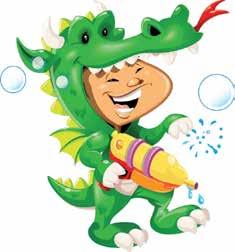
Summer school holidays
27 Dec 2009–24 Jan 2010
Holiday Fun Ticket
Includes Kids on Deck, Wetworld and Mythic Theatre Program: $10 per child/ adult, $25 family (2 adults & up to 4 children) Members FREE
Kids on Deck:
Explore mythic creatures
Children 5–12 years
Hourly sessions 10 am–4 pm daily
Enjoy the magic and mystery of dragons, unicorns and mermaids. Create your own mixed-up mythical shadow puppet and a stained-glass creature. Dress up in wings, tails, horns and fins!
Wetworld
(children 3–9 years)
10 am–4 pm daily
Fun-filled activities allowing children to explore and enjoy the properties of water: experiments in Wet Lab, exciting river races, Aqua Play and Super Soaker Action Zone.
Mythic theatre program
Children 5–12 years
10.30 am, 12 pm & 1.30 pm weekdays
Indonesian shadow puppets
Mon 4–Fri 8 Jan
Master puppeteer Jumaadi demonstrates the traditional art of wayang kulit – shadow puppetry.
Creatures of Greek mythology
Mon 11– Fri 15 Jan
Join drama workshops and create a world of ancient fantasy. In association with Powerhouse Youth Theatre
I, Bunyip
Mon 18–Fri 22 Jan
Be captivated by mythical Indigenous creatures including the mysterious mermaidlike Yawkyawks. In association with Erth.
FREE holiday activities!
Mythic Creatures adventure trail
Collect a self-guided discovery trail to investigate the Mythic Creatures exhibition.
Free family movie
Mulan
2 pm daily Sun 27 Dec–Sun 10 Jan
The Reluctant Dragon
2 pm daily Mon 11–Sun 17 Jan
20,000 Leagues Under the Sea
2 pm daily Mon 18–Sun 24 Jan
During school term
Family fun Sundays
11 am–3 pm every Sunday during term
Enjoy the magic and mystery of dragons, unicorns and mermaids. Create your own mixed-up mythical shadow puppet and a stained-glass creature to take home. Dress up in wings, tails, horns and fins!
Children 5–12 years. $7 per child or FREE with any purchased ticket.
Adults/Members FREE
Mini Mariners
Children 2–5 years + carers
10–10.45 am and 11–11.45 am Tuesday Tuesday 8 & 15 December
Pirates Follow the treasure map to find the secret loot, and make your own treasure to take home. Come dressed up to double the fun (not on Tuesdays 1 or 22 December).
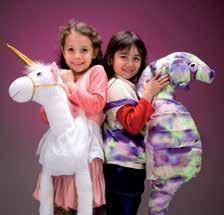
Tuesdays in February
Sail around the World Grab your passport and set off on an adventure to foreign lands. $7 per child. Adults/Members FREE. Bookings essential 9298 3655.
Booked playgroups welcome.
More information at www.anmm.gov.au
FREE family movies
1.30 pm every Sunday during term
Visit www.anmm.gov.au for full program
Mythical torchlight tours
6–7.30 pm Saturday 20 February and Saturday 24 April
Join mystery hunter Tim the Yowie Man and use your torch to track down the mythical creatures in our exhibition if you dare!
Children 5–12 years. $20 per child (Members $15). Remember your torch!
Special group rate
For 10 children or more $10 per child for a fully organised program of activities including:
• all museum exhibitions
• all children’s daily activities
• entry to destroyer HMAS Vampire and submarine HMAS Onslow
• FREE entry for 2 adults per 10 children
NB $4 extra per child for HMB Endeavour or 1874 tall ship
James Craig
Bookings essential.
Book early to ensure your space!
Phone 02 9298 3655
Fax 02 9298 3660
Email bookings@anmm.gov.au
Wetworld
Mythic Creatures children’s activities
SIGNALS 89 DECEMBER 2009–FEBRUARY 2010 27
Exhibitions



Mythic Creatures:
Dragons, Unicorns & Mermaids
19 December 2009–23 May 2010
North, South and Gallery One
For thousands of years, humans everywhere have brought mythic creatures to life in their stories, songs and works of art. Life-size models, engaging hands-on interactives, fossils, paintings, textiles and diverse cultural objects from around the world demonstrate the timeless allure of these strange and fantastic beings. Whether inspired by the natural world or by the imagination, together mythic creatures give shape to humankind’s greatest hopes, fears and dreams.
This exhibition is organised by the American Museum of Natural History, New York (www.amnh.org) in collaboration with the Australian National Maritime Museum; The Field Museum, Chicago; Canadian Museum of Civilization, Gatineau, Quebec; and Fernbank Museum of Natural History, Atlanta.
The seaside calls –Australian holiday posters
Until 7 March 2010
Tasman Light Gallery
From the Great Barrier Reef to Phillip Island ten posters from the Australian National Maritime Museum Collection promote holiday destinations during the 1930s–1970s.
On the water
Replica of James Cook’s
HMB Endeavour
Open daily 10 am–4 pm
Tour HMB Endeavour in museum mode.
Adults $18, child/concession $9, family $38. Members FREE.
Other ticket combinations available. Enquiries 9298 3777.
HMB Endeavour is setting sail again in April 2010! We are offering a range of voyages, from half-day family sails, to overnight leisure cruises, as well as five- and six-day extended offshore voyages.
For details go to www.anmm.gov.au/ endeavourvoyages or call 1800 720 577.
On the water
Barque James Craig (1874)
Daily Wharf 7 (except when sailing)
Sydney Heritage Fleet’s magnificent ironhulled ship is the result of an award-winning 30-year restoration. Tour the ship with various museum ticket packages (special discount for Members). The ship sails on alternate Saturdays and Sundays. Check www.shf.org.au for details.
Travelling exhibition
Exposed! The story of swimwear
Until 7 February 2010
Western Australian Maritime Museum
20 February–9 May 2010
South Australian Maritime Museum
Movie sirens, aquatic stars, bathing beauties, athletes, swimmers and designers have all played their part in the evolution of the modern swimsuit. Exposed! places Australian swimwear in a global context of design and swimming history, and popular culture.

Sail Away program
Joseph Banks and the flora of the Australian east coast
12 December 2009–20 February 2010
Warrnambool Art Gallery Victoria Engravings of Sydney Parkinson’s exquisite original botanical drawings from Cook’s first voyage.
Sail Away program
Little Shipmates – seafaring pets
16 December 2009–26 January 2010
Grafton Regional Gallery NSW
2 February–25 April 2010
Redcliffe Museum, Queensland
Cats, dogs, monkeys and birds – shipboard pets recorded by Sydney photographer Samuel Hood for over 50 years.
centre: James Northfield 1930s ANMM Collection
Courtesy James Northfield Heritage Art Trust.
right: Peggy Moffitt modelling Rudi Gernreich topless swimsuit 1964. Photograph by William Claxton
Courtesy Demont
Photo Management.
The seaside calls – Australian holiday posters
Mythic Creatures: Dragons, Unicorns & Mermaids
Exposed! The story of swimwear
SIGNALS 89 DECEMBER 2009–FEBRUARY 2010 28
Major sponsor


*Valid until the end of Feb 2010. Exclusive to Signals members only. Subject to availability and conditions apply. Based on twin share accommodation. RH912 THE SPECIAL ESCAPE HOLIDAY IS BACK BY POPULAR DEMAND. At Novotel Rockford Darling Harbour you can relax and unwind in one of our Standard Rooms and enjoy FREE full buffet breakfast. We are at the heart of vibrant Darling Harbour and conveniently located near... well... everything. Reservations 1800 606 761 sydney@rockfordhotels.com.au Proud supporter of the Australian National Maritime Museum $179* per room inc breakfast from Designed for natural living www.rockfordhotels.com.au SIGNALS 89 DECEMBER 2009–FEBRUARY 2010 29

Tours Sail on Endeavour in 2010
This exciting sailing program developed by our staff for the museum’s acclaimed replica of Lieutenant James Cook’s HM Bark Endeavour offers superb sailing adventures to suit your inclination – from Sydney Harbour day sails and overnight ventures to the real 18th-century squarerigger experience over several days and nights on the high seas.
SIGNALS 89 DECEMBER 2009–FEBRUARY 2010 30

Endeavour 2010 Voyage Program
Overnight Experience –as they did in Cook’s time 1–2 April
Steering by the stars
3–4 April
Joseph Banks’ adventures in botany 5–6 April
Voyaging in the wake of Cook
Price*: Able seaman (hammock) $230; Gentleman (cabin) $330
4 Hour Harbour Adventure –family fun and theatre
On 9 April and 10 April
Price*: adult $80 child $40 (child 7–15 years old) family $200 (2 adults 2 child)
High Sea Adventure –the voyage of a lifetime 11–15 April
Sydney–Broken Bay–Sydney 17–22 April
Sydney–Jervis Bay–Sydney 25–29 April
Sydney–Botany Bay
Prices* start at $1,150 for a voyage crew berth (you’re assigned to a watch and a hammock, take your turn to steer, handle sail and go aloft) and $2,300 for supernumerary berths (you’re assigned the replica cabin of one of the gentleman scientists and can opt for a more leisurely life onboard).
*Discounted rates are available to Members and volunteers of the Australian National Maritime Museum
The above schedule is correct at the time of printing. Minimum age limits apply for all activities. For more information, please visit our website at www.anmm.gov.au/ endeavourvoyage or contact the Endeavour office on 1800 720 577 or 02 9298 3859

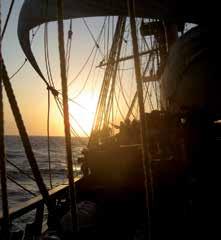
In April 2010 it will be 240 years since the compact, converted collier His Majesty’s Bark Endeavour, commanded by that extraordinary navigator and seaman Lieutenant James Cook, sailed into Australian waters on what would come to be acknowledged as one of the world’s most important voyages of exploration. That encounter, and the landing in Botany Bay on 29 April 1770, changed the continent’s history by setting it directly on course for colonisation and settlement by Cook’s own nation.
To commemorate this 240th anniversary, the Australian National Maritime Museum is offering a range of activities on board the replica of Cook’s vessel, HMB Endeavour, each of them designed to increase your enjoyment and understanding of this remarkable historic vessel. There is something for everyone from family half-day sails to overnight experiences on Sydney Harbour and short offshore voyages.
Specially suited for families, our Harbour Adventures add another dimension to history in the character of Able Seaman Antonio Ponto, portrayed by the museum’s talented in-house actor John Lamzies. Antonio Ponto was one of two Italians in Endeavour’s original crew. He will show the kids what life was like as an 18th-century sailor, while the ship makes its way around stunning Sydney Harbour. Adults can join in on these activities, or relax while viewing the harbour from the perspective of the Endeavour’s decks.
If an overnight adventure appeals to you, come along and try one of our Overnight Experiences on Sydney
Harbour over the Easter long weekend. You’ll enjoy the feel of the ship under sail as we make our way down Sydney Harbour to a mooring in sheltered waters. Tuck into an 18th-century-inspired dinner on the mess deck, before being lulled to sleep in a hammock. Each overnight experience has been given its own unique educational and historical theme, from 18th-century navigation to botany and exploration.
For the more adventurous, our High Sea Adventures offer the opportunity to experience blue-water sailing 18th-century style. You’ll stand watches, steer the vessel and handle sails just as Cook’s men did on the original Endeavour (while enjoying modern standards of comfort, hygiene, nutrition and safety at sea thanks to the modern galley, dining and bathroom facilities hidden away below the 18th-century decks). This is a unique opportunity to experience sailing on the world’s only working, full-scale replica of Cook’s ship.
There are three voyages to choose from. The first two are: Sydney and return via pristine Broken Bay; and along the NSW south coast from Sydney to Jervis Bay and return. Both will give you the opportunity to imagine how the coast of Australia looked to Cook and his men. Our final voyage for the 2010 schedule is Sydney to Botany Bay, which will see the replica vessel arrive in the historic bay exactly 240 years to the day since Cook made the first European landfall on the east coast of Australia.
So whatever your preference, in 2010 there’s an Endeavour program to suit you. Come along and join the adventure.
SIGNALS 89 DECEMBER 2009–FEBRUARY 2010 31
left: Endeavour replica under sail in Bass Strait 2006 en route to Melbourne. Photographer Steve Schmidt. All other photos ANMM
Tours
The floating world of Cambodia
Join us in November 2010 to explore the magnificent temples of Angkor and discover Khmer maritime traditions – both ancient and modern – on the Australian National Maritime Museum’s latest Asian cultural adventure. This exclusive tour, with World Expeditions, will be led by museum staff member and specialist in Asian history, culture and seafaring, Jeffrey Mellefont
THE NAME CAMBODIA, for most people, evokes the ancient temples of Angkor, those extraordinary testaments to a bygone civilisation founded by Khmer priest-kings over a millennium ago. Cambodia is rarely spoken of as a place with a maritime history to explore.
Yet the civilisations that flourished in Cambodia’s central plains and its junglecovered hills – creating huge religious monuments including their crowning achievement, the breathtaking, moated 12th-century temple of Angor Wat –depended upon massive works of hydraulic engineering to support the large populations of artists, artesans and labourers who built them.
The outstanding geographical feature of this region is a great inland water system, including South-East Asia’s longest river, the Mekong, and its largest lake, Tonle Sap. Together they rise and fall, flood and drain with the seasonal cycles of monsoon rain. Their inexhaustible fisheries, and the vast

agricultural lands they irrigated, allowed the mediaeval Khmer civilisation that created these great temple complexes to flourish.
It was here on these lakes and rivers that Khmer kingdoms battled and defeated their rivals in fierce naval engagements. Both the warfare and the daily lives of water-dwellers are depicted in friezes on some of the best-known Angkor temples. When their man-made canals and reservoirs silted up or failed as climatic cycles changed, the kingdoms faltered or fell to rivals. Today, these waterways support a vibrant maritime life of floating villages and traditional watercraft that extends to Cambodia’s tropical coastlines.
The Australian National Maritime Museum is partnering with travel expert World Expeditions to offer an affordable, 17-day Cambodian tour with a nautical theme unique to this museum. Our guests will gain insights into the surprising marine environment that supported the
great Khmer empire, while experiencing contemporary Cambodian life as it’s lived today on these same rivers, lakes and sea coasts.
Our tour takes in many facets of Cambodian history, from the arrival of Indian religions and arts with seaborne traders over 1,000 years ago to the French colonial period, independence and the turmoil of the mid-to-late 20th century’s Indo-Chinese conflicts. We’ll begin by flying direct to the regional town of Siem Reap to explore, over several days, a carefully chosen sample of the worldrenowned Angkor temples and associated water works.
Our tour then travels by boat across Tonle Sap Lake, encountering floating villages and bird sanctuaries, traversing lagoons and narrow waterways en-route to the colonial-style town of Battambang on the Sangker River. We will examine the graceful, traditional Cambodian touk (fresh-water wooden craft) in all its sizes and forms – as family transport, fishing
SIGNALS 89 DECEMBER 2009–FEBRUARY 2010 32

boat, house boat or floating market vessel – and inspect the riverbank boatyards where they are built using timeless techniques.
Moving to the capital Phnom Penh, we will stay in its charming French colonial quarter on the banks of the Mekong, enjoying palaces, temples, museums, markets and river tours. And then on the Cambodian sea coast, the tour will visit the colonial seaside resorts Kep and Kampot, and the national seaport Sihanoukville.
Cambodian cuisine – perhaps the leastknown of Asia’s culinary cultures – will delight our travellers with its distinctive styles based on rice and noodles, boosted by aromatic herbs and roots and interwoven with echoes of Thai, Laotian and Vietnamese cooking. Fresh and saltwater fish contribute much to this cuisine, and so does an astounding palette of tropical fruits. Highlights include the signature dish amok: baked fish, coconut, lemon grass and chilli in banana leaf.


The Kingdom of Cambodia is one of our region’s most exciting – and newest –travel destinations. Just ten years ago travel in some parts of Cambodia could still be hazardous as the last remnants of the brutal Khmer Rouge regime – which devastated the country during its rule from 1975 to 1979 – were surrendering. Understanding this turbulent recent history is essential to knowing our ASEAN neighbour Cambodia – now a forward-looking, youthful nation with a welcoming culture that you can help to support with your visit. (Government travel advisories now rate Cambodia a safer destination than Bali or Thailand.)
This exclusive tour builds on previous successful Australian National Maritime Museum cultural adventures with unique maritime-themed itineraries in Indonesia and India, led by ANMM staff member Jeffrey Mellefont whose travels, studies and publications focusing on Asian history, culture and seafaring span over 30 years.
from
A touk – the traditional Cambodian wooden boat –on the moat surrounding the 12th-century Vishnu temple Angor Wat.
Fig tree entangles the atmospheric Buddhist temple Ta Prohm, begun in 1186.
In Cambodian culture, local Khmer traditions fuse with Hindu-Buddhist imagery originating in India. All photography Jeffrey Mellefont
Cambodia Tour
19 November – 5 December 2010
Price $4090 including airfares
More information on page 25. Detailed trip notes at www.anmm.gov. au/membersevents. For tour preview and illustrated talk 6.30 pm 10 March 2010 call Members office on 02 9298 3644. For information and bookings call Kate or Fiona at World Expeditions, (02) 8270 8400, or toll free 1300 720 000 or email info@worldexpeditions.com.au.
clockwise
far left: Frieze on the 12th-century Bayon temple depicts a Khmer naval victory.
SIGNALS 89 DECEMBER 2009–FEBRUARY 2010 33
Whaling

Michael Dyer of the New Bedford Whaling Museum gained the inaugural USA Gallery Fellowship in 2008, studying overlapping histories at the Australian National Maritime Museum and in other Australian collections. In this essay he explores the themes of maritime commerce and the whaling fishery that linked early colonial Australia and early post-colonial America.
SIGNALS 89 DECEMBER 2009–FEBRUARY 2010 34
Departure of the whaler Britannia from Sydney Cove by Thomas Whitcombe (1763–1824). Oil on canvas, 1798. Reproduced courtesy of the National Library of Australia. The convict transport Britannia, reportedly the first vessel to take whales on the Australian coast, sails for England with a cargo of sperm oil. This painting was probably done for her owner Samuel Enderby.

linked our nations
Between roughly 1600 and the turn of the 20th century there was little that defined maritime nations more than their development of a deep sea whale fishery. Whaling demanded specialised tools and accrued marine knowledge. To be successful it also needed the technological and organisational backing and sophisticated port facilities that were the special province of maritime communities.
Pre-Civil War America was a maritime nation and so was colonial Australia. In the mid-19th century there was not one single city in Australia that was not a seaport, and between 1790 and 1850 both Sydney and Hobart became important whaling ports.
Unlike the dry but relatively benign climate of New South Wales and Tasmania, the rigours of a harsh northern climate in coastal New England in North America – and the equally harsh dictates of its puritan society – proved compelling motivations to develop an independent, self-regulating and largely communal, commercial whale fishery. In his 1788 treatise Observations on the Whale Fishery, Thomas Jefferson described the situation of New Englanders aptly: ‘Their country, from its barrenness, yielding no subsistence, they were obliged to seek it in the sea which surrounds them.’ The Quaker communities of Nantucket and later New Bedford, Massachusetts, concentrated their energies into shipbuilding, boatbuilding, smithing of all sorts, navigation, and the procurement of other commodities of industrial development through the profits generated from whaling.
The Australian colonial fishery, by contrast, was influenced by several quite different factors. The most prominent among these were the success of the 18thcentury American sperm whale fishery,
and the effect of the War of American Independence – as a result of which Great Britain could no longer rely upon a supply of sperm oil from its former colony. Additionally, large populations of sperm whales were found off the coast of New South Wales, while many convict transport vessels, having no return cargos after their passengers were off-loaded, proceeded to the whaling grounds close by. In this way the settlement of colonial Australia was a boon for the British southseas whale fishery
It is no coincidence that the whale fisheries of both Australia and the United States owe their existence to that supreme maritime power, Great Britain. In 1849 the British whaling entrepreneur Charles Enderby (1798–1876) would define the vitality of whaling as ‘congenial to our national habits’, a truly succinct and accurate assessment of the character of the British colonists and the nation that gave rise to them. Both Australia and America, as colonies, were commodity suppliers to British corporate entities such as the East India Company and governmental organisations like the Board of Trade, helping to ensure the markets of the empire.
English settlement of the great southern land enabled American maritime commerce to flourish around the world between the 1790s and the 1850s because, from the viewpoint of the average American whaleman and whaling agent, Australia provided a zone of comfort sitting directly adjacent to very productive whaling grounds. Writing in 1851, Herman Melville would call it ‘that great America on the other side of the sphere’. Around the same time the New Bedford whaling magnate John Avery Parker instructed the masters of his vessels to visit Sydney as it was ‘one of the best places in the Pacific’ to outfit and recruit.
Herman Melville would later call Australia ‘that great America on the other side of the sphere’
John Thomas Bigge, Commissioner of Inquiry into the governing of New South Wales under the Lachlan Macquarie administration (1810–1820), had strongly recommended the whale fishery in his 1823 Report of Commission of Inquiry on the State of Agriculture and Trade in New South Wales. He noted that ‘A more natural and profitable course of commercial employment or one that was more advantageous to the inhabitants, could not be devised.’
In 1835, 12 years after the Bigge report was published, Thomas Blythe, a London oil dealer, addressed ‘the colonists of Sydney’ to suggest improvements in the London oil trade. ‘The great sperm fishery is forever yours,’ he told them, adding prophetically that ‘you who possess the best branch of Australia’s commerce, may in time be the most distinguished individuals of your interesting colony. Your descendants may at a later period become the legislators of an independent state that may divide with the future republics of North America the consideration of the world.’ In this he seems to have foreshadowed Melville’s observation.
As the colony progressed, its citizens developed a proprietary view of the resources of their local seas and not all of the colonists were happy with increasing American activities in the region.
SIGNALS 89 DECEMBER 2009–FEBRUARY 2010 35
Among the few technological innovations adopted by the notoriously conservative Yankees was the toggle-head harpoon

On 13 February 1837, for instance, the Western Australia newspaper Perth Gazette and Western Australian Journal editorialised: ‘We welcome any and every stranger on our coasts, but it is painful for us to see strangers sweeping from us one of our richest harvests – the whale fishery – while we are indolent spectators.’
‘Indolent spectators’ maybe in Perth, but certainly not in Hobart and Sydney where at least 26 vessels made voyages to the whaling grounds of the South Pacific in that year.
Today we should never underestimate the importance to our forebears of the products derived from the sperm whale. Spermaceti candles were the first manufactured product of the American colonies, and sperm oil was the first cargo of export from New South Wales. The ship Britannia, Thomas Melville master, is reported to have been the first vessel to take whales on the Australian coast, after arriving as a convict transport in 1791. That first cargo was shipped under the agency of Samuel Enderby. The name Enderby looms large in British whaling history, and tangentially in Australian. For 50 years from the 1770s to the 1820s Samuel Enderby pioneered the British sperm whale fishery. He did this by studying the American industry in New England directly after the American Revolution, and encouraging Nantucket Quakers to command his vessels.
Even a major supplier of oil like Enderby, however, was subject to the rigidity of the English trade laws. In 1819 he had to seek special permission from the Board of Trade to send a vessel over 400 tons to hunt whales in the Pacific Ocean. He was granted permission but was forbidden to hunt whales in the Indian Ocean, a region of trade being the special province of the East India Company.
David Dickinson Mann, author of the 1811 Present Picture of New South Wales, was transported to the colony for forgery in 1799, and later pardoned. In Present Picture he advocated: ‘Vessels of neutral powers ought to be encouraged to trade to the settlement’ which ‘might look forward to the harvest of its toil … The independence of New South Wales would be greatly aided in consequence of these beneficial regulations’.
Foreign vessels were subject to port charges that, as James Kelly, whaling master of Hobart, indicated in 1820, ‘are a great burden to Colonial vessels, as they have to pay them whenever they go in and out of port.’ Kelly also reported heavy duties in England on oil being exported there in colonial bottoms. These questions of duties and port charges, especially for American vessels, remained an issue until well into the 1840s.
By the 1830s American vessels were ranging throughout the Pacific Ocean and had been for many years. The US Federal Government began to pay closer attention to the need for consuls in far-flung ports. The safety of the fleet became an issue too, after incidents such as the ship Independence of New Bedford running onto a reef at Vavau, Tonga, in 1837, and having to put away for Sydney for repair.
In 1838 Commander Charles Wilkes, leader of the famous United States Exploring Expedition, was given his instructions:
‘Sir, the Congress of the United States, having in view the important interests of our commerce embarked in the whalefisheries, and other adventures in the Southern Ocean, by an act of 18 May 1836, authorized an Expedition to be fitted out for the purpose of exploring and surveying that sea to determine the position of all doubtful islands and shoals …’
left: The Yankee-designed toggle-head harpoon became the industry standard from the 1840s. ANMM collection
right: A whaling scene of 1763, lithograph, Britton & Rey, 1874. In: Charles M Scammon, Marine Mammals of the Northwestern Coast of North America, San Francisco, 1874. Lithograph after a painting by William Allen Wall (1801–1885).
New Bedford Whaling Museum collection below right: Hobart Town 1856 by Henry Gritten, oil on canvas. Sail and steam vessels of various nationalities are depicted at anchor in the harbour, at a time when the port’s whaling facilities were at their peak. ANMM collection, purchased with the USA Gift
Wilkes’ visit to New South Wales marks a turning point in Australian-American relations. The American consul was already on the job working towards making Sydney a port free to American vessels. Wilkes’ narrative would be published in 1845 with its account of ‘the glorious colony’, while American whaling agents were looking to Sydney as a port of safety and refreshment.
In July of 1842, US Consul James H Williams began advocating with Government House for a remittance of port charges for foreign whalers visiting Sydney, as well as permission to sell a portion of their oil to offset refitting and repair costs. He wrote to James Forsyth, US Secretary of State:
‘George Gipps and the Colonial Secretary in some private conversations which I have had with them have both expressed the strongest desire to see an increased intercourse between the colony and the United States and I have hopes that if not found unacceptable with the provisions of the British Navigation Acts, United States whaleships will be admitted here for purposes of refreshment, etc. free of port charges.’
Such a policy was already informally in place in Hobart, resulting in steady American usage of the port. The decision was finalised by the colonial government in February of 1845 and within one year the number of American vessels using the port of Sydney had quadrupled.
The 1850s were the apex of New Bedford’s whaling trade. Three hundred and twenty-nine whaling vessels were registered in the New Bedford port district in 1856. Both sides of the Acushnet River were involved in the industry. On the Fairhaven side were shipyards, sail lofts, shipsmiths and cooperage. There was a candle works and oil refinery as well. On the New Bedford side were at least
SIGNALS 89 DECEMBER 2009–FEBRUARY 2010 36
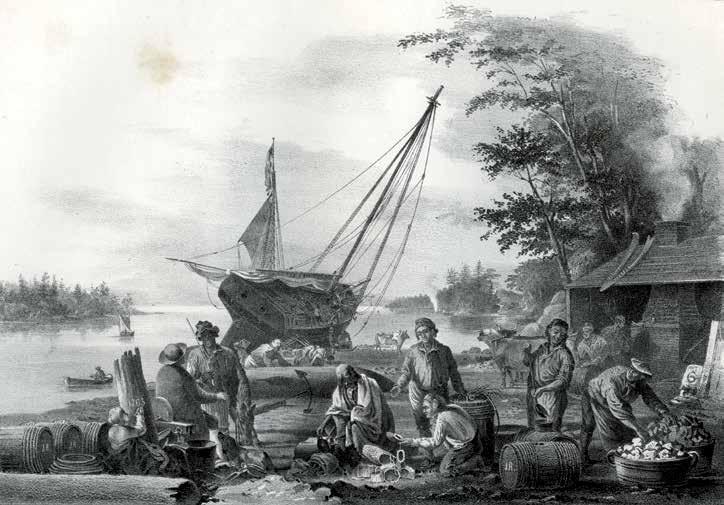

SIGNALS 89 DECEMBER 2009–FEBRUARY 2010 37
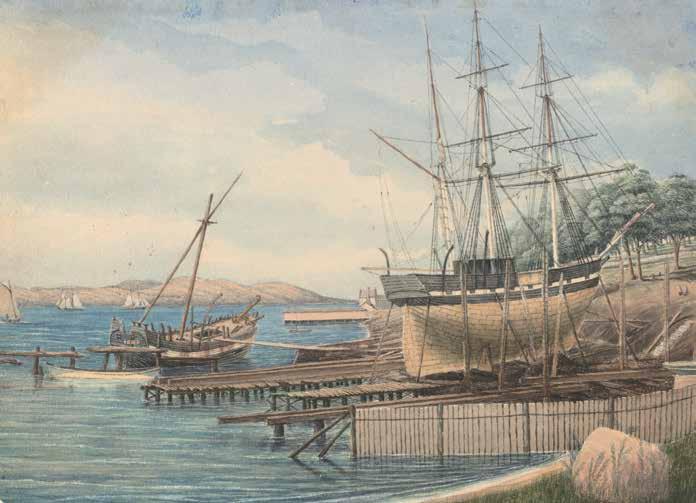
13 oil refineries and candle houses where the produce from all the world’s oceans was processed and distributed.
One such facility, the New Bedford Cordage Company, was owned and managed by three of the principal merchants, ship owners and whaling agents of the port. It specialised in the production of ¾-inch (19 mm) Manilla whale line. Masters and officers swore by it and would use no other. On the other side of the sphere Solomon Levey (1794–1833) of Sydney was said to have managed a rope works in Sydney and while a rope walk is listed in the numbered ‘References’ of the 1822 Plan of the Town and Suburbs of Sydney, its actual location remains elusive. However it’s not clear that he made the more specialised whale line.
An important ingredient in the success of the American whale fishery was the highly specialised production of harpoons, lances, spades and other tools of the whaling trade. Among the few technological innovations adopted by the notoriously conservative Yankees was the toggle-head harpoon, developed in the
late 1840s and produced in thousands. It became the industry standard replacing the age-old double-flued iron and the recently adapted single-flued iron.
By contrast, the March 1845 Sydney General Trade List reported that the bark Lucy Ann owned by whaling agent Ben Boyd returned to port ‘as no dependence could be placed in either harpoons, lances or spades’. An 1837 Imlay Brothers account book held at the Mitchell Library reveals that these Eden-based whaling agents purchased their gear from a wide variety of local sources. A T Lowes provided oars, a whaleboat and 12 lances; a McMichael provided blubber forks, skimmers, spades and cutting falls, and a P Stephanson, probably a local blacksmith, provided boathooks, can hooks, bolts, nails and repaired three harpoons. Repairing harpoons implies that they were not necessarily available from local manufacturers.
Hobart’s famous whaling master James Kelly noted that in the 1820s ‘harpoons and lances and good casks can only be obtained from England on order [and] whale line likewise must be made up in
England.’ However Kelly also indicated that whaleboats were of local manufacture, easily obtained and of higher quality.
Evidence suggests that Walsh Bay, between Millers Point and Dawes Point in Sydney Harbour, was the centre of Sydney’s whaling trade, where the wharves, warehouses and repair facilities for the whaling fleet were located. Towns’ wharf, Aspinall and Brown’s, Lamb’s, Walker’s and Pitman’s wharves were all located here. Campbell’s wharf was around the corner in Sydney Cove (now Campbells Cove) and the patent slip was in Darling Harbour just to the west. Ford’s Sydney Commercial Directory for 1851 lists eight block and mastmakers, 27 clothiers and outfitters, 21 boatbuilders, 20 sailmakers, three ship chandlers, 38 coopers and 65 shipwrights. The port was no longer simply a colony of convicts and governmental managers, it was now a major south seas seaport.
Shipbuilding and the ability to survey, refit and re-rig sailing ships damaged or worn out on their long voyages were among the most valuable features of
SIGNALS 89 DECEMBER 2009–FEBRUARY 2010 38

Sydney Harbour. Charles Wilkes had reported that ‘The facilities for outfits here are such as are not to be found elsewhere in the Pacific’. Wilkes’ sentiment was echoed by US Consul Williams and subsequently by Colonial Secretary Gipps. In Gipps’ memorandum to Colonial Secretary of State Lord Stanley he emphasised the economic advantages of visits by foreign whalemen:
‘As many as forty American and twenty French whalers have been laying in Hobart Town at one time. These ships spend upon an average of £500 each the whole of which is in cash. They employ the mechanics and consume the provisions and merchandise of the colony. There is no other port in this section of the world which offers equal facilities for the supply and repair of whale ships with Sydney …’ Consul Williams had been involved in Sydney business affairs as a commission merchant since 1834. He opened the consulate in 1839 and by the mid-1840s had partnered with Simon Wilkinson Jr. Wilkinson was also a commission merchant, a class of men whose
reputations or recommendations from supporters brought them business. They were authorised or ‘recommended’ to receive, buy and sell goods and merchandise and to generally transact all sorts of business on both their own accounts and the accounts of other American whaling agents.
When Great Britain passed the 1845 Act espoused by Consul Williams, to allow American whaling vessels free access to Australian ports, an American commission merchant, R F Breed – in Liverpool acting on behalf of the Maning Brothers, general merchants of Hobart –sent out a circular to American whaling agents encouraging the facilities of Hobart Town. Breed quoted letters from Maning Bros. stating: ‘Provisions and vegetables, carpenters, blacksmith’s work and boat building are all cheaper at Hobart Town than at Sydney and New Zealand’. They extolled the climate as being ‘the most congenial to the restoration of the health of ship’s crews that have been long at sea’, emphasising as well that ‘the law respecting seamen is so strict (being a penal colony) that
American whaling masters had a choice of two very sophisticated seaports in the southern hemisphere
L to R: Patent slip, Hobarton, Tasmania, by William Daniell c. 1850. Watercolour. Reproduced courtesy of the National Library of Australia. The ability to survey, refit and re-rig sailing ships was among the most valuable features of Australian ports. In 1860, for instance, the bark Stephania of New Bedford went ashore at New Zealand in a gale of wind and damaged her keel. Leaking badly, she put into Hobart and was hauled up the Patent Slip, overhauled and repaired. USA Gallery Fellowship holder Michael Dyer of the New Bedford Whaling Museum, photographed in the museum’s USA Gallery, with its dramatic recreation of a 19th-century whaleboat (lent by Mystic Seaport in the USA). Photographer J Mellefont/ANMM
captains of whale ships have little trouble with their men’.
American whaling masters thus had a choice of two very sophisticated seaports in the southern hemisphere.
Each of these ports had their own whaling fleets, knew the needs of whaling vessels and by mid-century had the infrastructure and commercial facilities in place to ensure that the whaling fleet had full marine services close to their cruising grounds. Under the influence of British colonial rule they had become major seaports servicing the commerce of Western expansion.
The USA Gallery is the enduring legacy of a generous endowment, which was the USA’s gift in 1988 for Australia’s bicentennial of European settlement in 1788. Its purpose is to showcase the longstanding maritime links between the two culturally-related nations on either side of the Pacific Ocean.
The USA Gallery occupies a unique place in the international museum world as a gallery in a national museum funded by another nation. The gallery was officially opened in 1992 by President George Bush (senior).
SIGNALS 89 DECEMBER 2009–FEBRUARY 2010 39
Tales from the wall
Aussie football legend from war-torn Beirut
Many names on the Welcome Wall come with inspirational stories of triumph over the trials of war and displacement. Karen Worsfold talks to local football hero Hazem El Masri, a popular guest speaker at our most recent unveiling of new panels of subscriber names.

Champion National Rugby League player Hazem El Masri’s name was unveiled on the Welcome Wall on 27 September 2009, just two days after his retirement from the sport he loves. He was one of the speakers who addressed a crowd of over 1,000 people – family and friends of new subscribers to the Welcome Wall who came along to see their names cast into the new bronze plates that we install at least twice a year as part of our ongoing tribute to all who have migrated to our nation.
Affectionately known as ‘El Magic’, our guest speaker Hazem El Masri was born in 1976 and grew up in war-torn Lebanon. The second of six children, he remembers waking up at night to the thunder of shelling and loud bombs and praying with his family for their safety. It was too dangerous to venture out during the day for fear of shelling and shooting, and Hazem remembers accompanying his father on late night journeys to the bakery to obtain food supplies, because it was the only time that shopkeepers dared to open their stores.

Welcome
Hazem El Masri and his wife Arwa at the Welcome Wall unveiling, 27 September 2009. Gennelle Bailey/ Bailey Photography
SIGNALS 89 DECEMBER 2009–FEBRUARY 2010 40
The museum’s tribute to migrants, The Welcome Wall, encourages people to recall and record their stories of coming to live in Australia
Hazem remembers the buzz and excitement of the win … all anyone talked about in his new country was Rugby League
unmatched 305 times over 14 seasons for the club. He holds the Bulldogs club career points record, the record for the most points scored in a single match, and the NRL point-scoring record for a single season. In 2009, he took the record for the highest-ever point scorer in premiership history.
Hazem’s representative career included playing as a New South Wales State of Origin winger, and playing for the City side in the annual City vs. Country fixture. He captained the Lebanese team in the 2000 Rugby League World Cup, as well as playing for Australia against New Zealand in 2002.
For the young Hazem, soccer provided an important and temporary escape from the surrounding terror and destruction.
Arriving in Australia in 1998 when Hazem was 12 years old, his family settled in south-western Sydney. Those early years in Australia were challenging for Hazem’s parents, Khaled and Amal. They had five children, little money and faced language barriers in their new home. They derived comfort and support from their local community and their Muslim faith. As Hazem says of his first years in Australia: ‘The biggest aspect of it all is that you’re actually safe – you are in your own home and no-one can come and say “Get out!” for no reason.’
Hazem was first introduced to Rugby League by his cousins at a family barbeque. He was handed on oddly shaped ‘ball’ and given a brief rundown on the rules of the game. It was 1988, and the Bulldogs had recently won the National Rugby League grand final. Hazem remembers the buzz and excitement of the win, and that all anyone talked about in his new country was Rugby League. To his parents’ dismay, Hazem switched from playing soccer to this new and (to them) unfamiliar code, joining his local club, the Enfield Federals. In 1994 he was spotted by talent scouts from the Canterbury Bulldogs while playing for his school side, and was invited to trials. Just two years later, at the age of 19, he made his debut in the Bulldogs’ first grade team and by 1998 he was a regular member of the squad.
Hazem went on to carve a stellar professional career with the Bulldogs. He played his entire club football career with the team and appeared an
In June 2009, Hazem announced his retirement from rugby league, playing his last game against the Parramatta Eels in the preliminary final on 25 September. He is remembered with great affection and admiration by his Bulldogs fans as a legend of the game.
Off-field, El Masri is devoted to his family and three children, Lamya, Zayd and Serene. He met his wife, Arwa, when she interviewed him as an English and Arabic literature student for the University of Western Sydney’s newspaper. Arwa had arrived in Australia in the mid-1980s from Saudi Arabia with her Palestinian-born parents.
El Masri is widely admired and respected for his extensive work in the community as a role model for young people, and as a representative of our Lebanese and Muslim communities.
Unveiling the new names on the Welcome Wall, Hazem said: ‘Coming to this country and the things that this country provided to me is just unbelievable. You always want to be thankful and you always try to give back as much as you can, and along the way I found Rugby League, and I guess in a way it touches the hearts of people, because sport just unifies people … I’ve loved every single minute of it, because it’s been the opportunity to give back something to the community, to these teenagers and kids, give them some inspiration, something they can strive for.’
We are delighted to include Hazem and Arwa El Masri and their stories on the Welcome Wall.
For further information see El Magic: The Life of Hazem El Masri by Bill Wood, Harper Collins, 2007.
The Welcome Wall
It costs just $105 to register a name and honour your family’s arrival in this great country! We’d love to add your family’s name to the Welcome Wall, cast in bronze, and place your story on the online database at www.anmm.gov.au/ww. So please don’t hesitate to call our staff during business hours with any enquiries on 02 9298 3667.
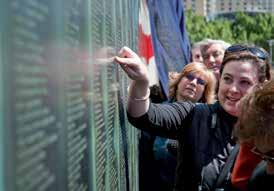

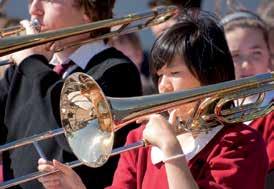
SIGNALS 89 DECEMBER 2009–FEBRUARY 2010 41
This recently acquired lithographic movie poster gives another perspective on a World War I naval victory that’s normally portrayed as an Australian triumph, and the ‘first blooding’ of our newlyformed navy. By Bill Richards and Eva Jaku
This historical movie poster was made to promote the German film made originally as Kreuzer Emden, a docudrama about the World War I action between the raider SMS Emden and the Australian cruiser HMAS Sydney The film was produced in Germany well after the war ended and was first screened in 1928, when Germany was experiencing a new groundswell of patriotism. Kreuzer Emden was one in a spate of films that recalled Germany’s heroic activity in the Great War of a decade earlier that had such catastrophic ramifications for the losing side.
The hyper-stylised image, by an unknown artist, is a declaration of human strength in crippling conditions. It’s a heroic scene made even more heroic by the wounded sailor whose reclining position and composition recall the vision of the dying Nelson in the famous painting Death of Nelson (1864) by Daniel Maclise.
From the large movie house Muenchener Lichtspielkunst A G (or Emelka), the film told the story of Germany’s Dresden-class cruiser SMS Emden and the ship’s unorthodox commander, Captain von Mueller. It follows Emden through the early months of the war as it pursued and captured merchant ships of various nationalities. Von Mueller’s self-imposed code of honour impelled him always to allow the vanquished crew and passengers to return home unharmed.
Emden’s exploits came to an abrupt end on 9 November 1914 when the raider was intercepted and destroyed in the Indian Ocean by the Australian cruiser HMAS Sydney. Escorting the first ANZAC convoy to the Middle East, Sydney was diverted to investigate reports of
Two sides to a war story
a warship off Direction Island in the Cocos Archipelago. Emden had just detached a shore party to destroy the British cable and wireless station. The German ship stood out to meet Sydney, but was quickly overcome by a faster and more powerful opponent. It was pounded heavily and driven ashore on North Keeling Island.
Kreuzer Emden, a silent film in blackand-white, tells the story from the German perspective. The well-known actor Louis Ralph was both its director and lead actor in the role of Captain von Mueller. After its release in the United States, reviewer Mordaunt Hall wrote in The New York Times that it gave a ‘brief conception’ of the exploits of the courageous Captain von Mueller and the sinking of his vessel.
‘Life aboard the Emden is depicted splendidly,’ he wrote. ‘In the fight between the Emden and the Sydney, although the former was hopelessly outgunned, excellent effects are obtained by flashing from one vessel to the other … So long as (the film) keeps to the actual exploits of Emden and her dramatic encounter with the Australian vessel it is absorbing …’
The large 1100 mm x 830 mm fullcolour poster was produced in English for this American release by the Otis
It’s a heroic scene made even more heroic by the position and composition of the reclining wounded sailor
Lithograph Company, active in the early 20th century and contracted by many movie studios including Columbia and Warner Brothers. Otis Lithograph Company was a key contributor to the development of lithographic movie posters, employing some of America’s finest modernist artists.
Initially conceived as a cheap, everyday advertising medium, poster art has evolved beyond its original intention into an art form that connects with its audience in new ways. The medium is no longer seen as secondary, and early works (such as this one) have come to be recognised in their own right as important contributors to the visual arts.
The movie studio art department would ship the original movie ad artwork to the lithographer who was not allowed to make any changes to the size or placement of stars’ names in relation to the film’s title, without first checking with the studio. The early lithographers worked on huge limestone slabs, giving rise to the somewhat tautological term ‘stone lithography’.
Each lithographer had a method for keeping track of plates, and master plates were freqeuntly reused when studios required more posters. The litho numbers were a type of reference of filing numbers to locate master plates. Some early Otis posters have plate numbers on the bottom of the oval logo, seen at lower right of this example. Later posters were stamped with a rectangular logo with plate number.
This lithographic poster is an important addition to the museum’s holdings, both as a fine example of 1920s movie poster art and as a reminder of the importance of the World War I encounter between HMAS Sydney and SMS Emden – and not just from the Australian perspective.
Collections
SIGNALS 89 DECEMBER 2009–FEBRUARY 2010 42

SIGNALS 89 DECEMBER 2009–FEBRUARY 2010 43
Readings
A very amorous spark
The Female Shipwright by Mary Lacy (first published 1773). National Maritime Museum, Greenwich, 2008. Hardcover, 170 pp, ISBN 978-1-906367-01-5. RRP $26.95
This charming book is a fascinating firsthand account of the trials of life at sea for a young sailor in the 1750s. What sets it apart is the fact that it is a true story written by Mary Lacy who, at the age of 19, ran away from home, disguised herself ‘in men’s apparel’, and took the name William Chandler – ostensibly after an unhappy love affair but in fact, we suspect, to escape a life of boredom and domestic drudgery at home. As such, it is in the tradition of that fascinating –and not so uncommon – historical phenomenon of women cross-dressing in earlier, less permissive times, whether to join the navy or the army, or to be close to a lover.
So begins a life of extreme hardship laced with action and adventure. For Mary the privations of shipboard living – the gruelling physical labour, the poor quality and scarcity of food, the perils of the ‘loathsome’ sick berth, the sometimes violent temper of her masters – are compounded by the constant fear of her sex being discovered. Her descriptions of the manoeuvrings necessary to prevent detection are disarmingly candid, and also a source of considerable (if unintentional) humour. This is particularly so when referring to the common custom of sharing beds (presumably because there weren’t enough to go around in those days) and the random allocation of sleeping companions, both male and female. We can only agree it is ‘next to a miracle’ that her sex is not discovered, and we are left wondering how this could possibly have been the case!
The style of narrative is straightforward and unpretentious, and the direct address to the reader invites an easy familiarity. We share the author’s delight, for example, at a rare opportunity to use soap and water: ‘How glad was I!’ or at being given a clean set of clothing: ‘Hardly being able to contain myself for joy!’ And the letters to her parents signed
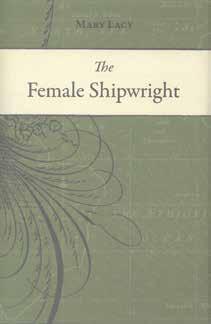

‘Your undutiful Daughter, Mary Lacy’, and the replies signed ‘Your afflicted Father and Mother’ are particularly poignant.
Although the author often sermonises on the folly of leading an undisciplined and irresponsible life, and laments the grief she has caused her parents, it seems unlikely that Mary would have been content to settle into the life of sedentary domesticity that society would otherwise have ordained for her. Contrary to her words of warning to other ‘young maidens’, we sense she would not have missed the relative freedom of life at sea for the world – a cautionary tale, but a tantalising adventure at the same time!
The author also has something to say about the sexual mores of the day. She notes that single women were frequently brought on board: ‘I soon had reason to believe they were not married, from her impudent behaviour … and could discern their vicious inclinations immediately.’ Elsewhere she observes: ‘I thought it no wonder the young men took such liberties with the other sex, when they gave them such encouragement … when a young woman allows too much freedom, it induces the men to think they are all alike.’ What we might now from a more
permissive cultural perspective consider prudery might simply reflect the morality of the time – or could it perhaps represent an opportunity for the writer to indirectly scandalise her contemporary readership?
The exact nature of the relationships that Mary had with other women is never made explicit, although it is clear that she enjoys female company, to the extent that her master and others conclude that she is ‘a very amorous spark when in the company of women’. The final chapter is less than crystal-clear on this point – an idyllic conclusion of marital bliss? You will have to read the book and come to your own conclusion!
This unassuming though attractively presented book will probably not take out any literary awards, but on its own terms it is a gripping read. It is a simply told but absorbing tale that captures the reader’s imagination and holds it from the first page to the last. In its simplicity and candour, it contains astute commentary on human nature – and wry observations on human weaknesses – that ring true through the ages, and leave us feeling that ‘the more things change, the more they stay the same’.
Penny Crino, assistant editor
SIGNALS 89 DECEMBER 2009–FEBRUARY 2010 44
2009 Frank Broeze maritime history book prize winner
Winner: John Gascoigne
Captain Cook:
Voyager Between Worlds (left)
John Gascoigne’s highly praised book Captain Cook: Voyager Between Worlds (published by Hambledon Continuum, London 2007) has won the fifth Frank Broeze Memorial Maritime History Book Prize, sponsored jointly by the Australian National Maritime Museum and the Australian Association for Maritime History.
The winning work of maritime history, and the short-listed entries, were announced in Fremantle, Western Australia, at the Annual General Meeting of the Australian Association for Maritime History in early December. The biennial $2,000 cash award is for a book treating any aspect of maritime history relating to or impacting on Australia, written or co-authored by an Australian citizen or permanent resident. The 2009 award was for works published between 1 January 2007 and 31 December 2008.
The prize was first awarded in 1992, not long after the Australian National Maritime Museum first opened to the public, to promote a broad and revitalised view of maritime history. In 2001 the prize was renamed in honour of the late Professor Frank Broeze (1945–2001) of the University of Western Australia, who introduced Australia’s first university course on maritime history and helped to redefine the field, reaching into economic, business, social and urban histories.
This year’s winner examines the period when the supreme navigator and explorer James Cook entered the world of the South Pacific. Both societies – British and Polynesian – were highly accomplished in exploiting the seas in vessels hand-built by skilled artesans, powered by human muscle, navigated by human knowledge and ingenuity. In virtually every other respect these societies differed, in varying degree. Professor Gascoigne explores these differing worlds – their trade, politics and war, religion and culture, even their attitude towards sex and death. He examines what happened when the two cultures met, and how each one interpreted the other.
The judging panel comprised two Western Australian scholars nominated by the Australian Association for Maritime History, Associate Professor Tony Barker and Emeritus Professor Peter Reeves , as well as the director of the Australian National Maritime Museum, Mary-Louise Williams. Among their comments:
‘Gascoigne has a very distinctive approach to the Cook literature … Its attempt to see the cultural interactions from both sides has to deal with a wider range of the latter than most historians contend with, and he’s done it very well.’
‘It’s an interesting twist on the life of a well-known and important historical figure. It’s very well written and researched and the supporting illustrations and maps are confidently well placed throughout the book. A highly professional publication.’
‘An absorbing account of Cook’s career that made clear that in every aspect of his life he was deeply involved in the maritime world.’
More about the winner
Professor John Gascoigne was educated at the Universities of Sydney, Princeton and Cambridge. He has taught in Papua New Guinea and since 1980 has been a member of the School of History, University of New South Wales.
He is a fellow of the Australian Academy of Humanities. His five previous books and other publications have dealt with
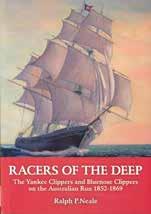
the impact of the Scientific Revolution and the Enlightenment and include a two-volume study of Joseph Banks and his world.
The other short-listed authors for the 2009 Frank Broeze Memorial Maritime History Book Prize, each one eliciting praise from judges, are listed below.
For further information contact:
Jeffrey Mellefont, Publications Manager, Australian National Maritime Museum 02 9298 3647 0419 447 894 jmellefont@anmm.gov.au
2nd: Ralph P Neale
Racers of the Deep: The Yankee Clippers and Bluenose Clippers on the Australian Run 1852–1869 (Australian Scholarly Publishing Pty Ltd, Melbourne VIC 2007). Well researched, it makes a worthwhile contribution to a neglected, albeit brief, era of Australian maritime history and includes fascinating stories of the clipper captains, crew and passengers.
3rd: Diane Kirkby
Voices from the ships: Australia’s seafarers and their union (University of NSW Press, Sydney NSW 2008). This is an important history of the seafarers union and the emergence of the Maritime Union of Australia.
4th: Chris Pash
The Last Whale (Fremantle Press, Fremantle WA 2008), a valuable account of the battle to end whaling in Australia, portraying both the workers in the industry and the activists who made such an important contribution to this ecological maritime battle.

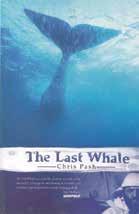
Readings
SIGNALS 89 DECEMBER 2009–FEBRUARY 2010 45
Currents Bienvenue
Valérie!
In November the museum hosted a guest intern Valérie Vattier, Directrice du musée de l’histoire maritime de NouvelleCalédonie (director of the New Caledonia Maritime Museum). Valérie first met ANMM director Mary-Louise Williams in May this year when holidaying in Sydney. From this meeting grew the proposal that Valerie come here for a professional development internship. The internship was jointly funded by the ANMM and NCMM, as part of our own important outreach suite of programs. Both directors valued the opportunity to exchange knowledge between the two museums and hope to continue this relationship into the future.
Originally a geographer, Valerie left her native Normandy, France for New Caledonia in 1996 and took up the helm of the museum in 2003. The New Caledonia Maritime Museum has a strong working relationship with the Musée national de la Marine in Paris – one of ANMM’s overseas collaborators and a source of major international exhibitions that we have brought to Australia. Valerie is hoping to develop similar relationships with other museums in the Pacific region.
The New Caledonia Maritime Museum recently celebrated its tenth anniversary. The well-equipped museum has both core and temporary exhibition galleries and a conservation lab. Employing six staff members and 30 volunteers, it is jointly governed by the New Caledonia Government, the South Province of New Caledonia, the Port Authority and the Noumea municipality.

navigational tools and a set of perfectly preserved liqueur glasses recently discovered within a coral reef.
local designers. Valerie has expressed an interest in working with Australian designers at her museum in the future.
The museum’s most important collection relates to the 18th-century French naval officer and explorer La Pérouse who led a scientific expedition to the Pacific with the aim of completing the discoveries of James Cook. The voyage ended in disaster with both of the mission’s vessels, Boussole and Astrolabe, wrecked off the Solomon Islands. The collection contains thousands of items from these wrecks including rare
NCMM’s core gallery has seven themes which explore the La Pérouse collection, convicts, migration of Melanesian and French settlers, New Caledonia as a trading hub including the sandalwood and nickel trades, and the impact of the American Allied Forces stationed there during WWII. After ten years these galleries are ready for a revamp. While at ANMM Valerie worked with our Design team to see how we plan and develop our core exhibitions, and networked with
Valerie and our curators also spent many hours together discussing the various shared and similar maritime stories of Australia and New Caledonia, particularly convict transportation, European settlers, trade ships and indigenous communities. And of course, La Pérouse!
Clare Power, project assistant and MMAPSS coordinator
SIGNALS 89 DECEMBER 2009–FEBRUARY 2010 46
right: Artists of the Urab Dance Team from Poruma Island in Torres Strait visited the museum in late September to perform a selection of the famous dances that are such an important feature of the Torres Strait islands cultures. They are pictured on the museum’s new harbourside performance deck. Photographer S Andrews/ANMM
below and bottom right: Remembrance Day, 11 November, was marked by services and ceremonies on the museum’s new performance deck. Once again the activities focused on the famous WW2 vessel Krait, which carried out a successful commando raid on Japanese-occupied Singapore in 1943. Krait is managed by the Australian National Maritime Museum on behalf of the Australian War Memorial. Photographer J Mellefont/ANMM
opposite: Photographer Vincent Guigueno


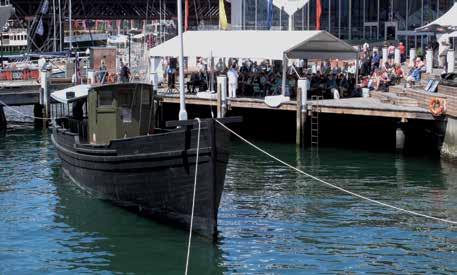
Museum sponsors Corporate Members
The
Project
National
Wallenius
Zim
Captain
Defence
HMAS
HMAS
HMAS
HMAS
HMAS
HMAS
Maritime
Maritime
Maruschka Loupis & Associates
Penrith
Pivod
Regimental
Royal Caribbean & Celebrity Cruises
Svitzer Australasia
Sydney Pilot Service Pty Ltd
Foundation sponsor ANZ
sponsors Blackmores Ltd Channel Nine
Register Asia
Australia Pty Ltd Tenix Pty Ltd
Major
Lloyd’s
Raytheon
sponsors Akzo Nobel Coral Sea Wines
Maritime Services Pty Ltd Louis Vuitton Novotel Rockford
Foundation
by Sail Founding patrons Alcatel Australia ANL Limited
Airfreight
Lend Lease BP Australia
& Joy Reid Foundation
Seafood Restaurant
Smith Limited James Hardie Industries
Defence
Silentworld
Sydney
Ansett
Bovis
Bruce
Doyle’s
Howard
Australia Bank
TG & MG Kailis
Nedlloyd Ltd Telstra
PG,
P&O
Wilhelmsen Logistics
Banking Corporation
Westpac
Shipping Australasia
program provides corporate Members privileged entry to the museum’s unique environment for
hospitality. Three membership levels each provide a range of benfits and services: Admiral three-year membership $10,000 one-year membership $4,000 Commodore three-year membership $5,000 one-year membership $1,850 Captain three-year membership $1,800 one-year membership $700
Membership Ferris Skrzynski & Associates Pty Ltd
corporate
Admiral
Memberships
Exhibitions Australia Ltd
Shipping Services Pty Ltd
Japan Cable Ltd
Art
Asiaworld
Australia
National Storage-RPA
Creswell
Kuttabul
Newcastle
Penguin Welfare Committee
Vampire Association
Watson Ships
Fund
Workers Credit Union
Union of Australia (NSW Branch)
Returned Services League
Technologies Pty Ltd
Trust Fund, Victoria Barracks
Currents SIGNALS 89 DECEMBER 2009–FEBRUARY 2010 47
Bearings from the director, Mary-Louise
Williams
One of the leading articles in this edition of Signals tells the story of the year’s most exciting addition to the National Maritime Collection, the three Polynesian artefacts known as the ‘Omai relics’ that were collected during James Cook’s second circumnavigation. Their provenance is remarkable, since they had remained in the family of their collector, master of HMS Adventure Tobias Furneaux, until very recently. They add great depth to our holdings relating to Cook, Pacific exploration and the cultural exchanges that took place.
The interest generated by Cook and his achievements seems to be endless. On page 45 we announce the winner of the 2009 Frank Broeze maritime history book prize, John Gascoigne’s superb book Captain Cook: Voyager Between Worlds This journey into the cultures of two great maritime societies – those of 18th-century England and Polynesian Tahiti – is a fine contribution to Cook scholarship.
As one of the three judges of this biennial prize worth $2,000 , I can attest to the high standards of work that it has attracted since we developed it back in the early 1990s in association with our colleagues of the Australian Association for Maritime History. It’s often a very difficult selection to make, but this time the winner of our prize was a unanimous
choice. Nonetheless I could recommend any of the award finalists to those looking for a rewarding addition to their coming summer holiday reading list.
Also in this edition of Signals (and still on Cook-related topics!) we announce the 2010 sailing schedule for our superb museum ship, the replica of HM Bark Endeavour. We are very pleased to be setting sail again, and giving our public the opportunity to experience and take part in 18th-century seamanship, under the guidance of our experts.
We know quite well that this museum is a much-appreciated part of the country’s cultural and historical landscape – our visitor figures tell us that, and so does the strength of our Members program and the loyalty of our volunteers. But it’s always nice to get another take on how the world sees us and our work. Britain’s The Sunday Times has recently named the Australian National Maritime Museum one of the top 12 ‘cool museums’ in the world! It’s the only Australian museum on the list, and it ranks us in an elite group along with The Science Museum in London, Musée de Quai Branly, Paris, and the American Museum of Natural History, New York. (Clearly no co-incidence that we’ve partnered with the latter in delivering our cool new

summer exhibition Mythic Creatures: Dragons, Unicorns & Mermaids, featured in this edition of Signals on pages 2–9).
‘For any visitor,’ the article says, ‘Sydney is defined by its dazzling blue harbour, and that’s what makes a trip to the National Maritime Museum so essential. Its fleet of ships of all sizes is limitlessly fascinating, and for an extra charge you can board almost all of them. There’s a naval destroyer, a submarine, even a Vietnamese fishing boat that docked in Darwin with 31 refugees in 1977. Best of all is the Endeavour, an ocean-going reconstruction of the Whitby collier in which Captain Cook “discovered” Australia.’
A warm welcome to the two newest members of our museum’s governing Council, appointed recently by the Australian Government. Shane Simpson has a long involvement in the arts in Australia. He is a solicitor with his own practice that specialises in intellectual property, arts, entertainment, media, museums and law related to the new technologies. He was founding director of the Arts Law Centre of Australia and has served on numerous arts boards. Shane was the first chair of Museums and Galleries NSW; I served on this board with him and took over from him as chair. We welcome the depth of experience of the arts and knowledge of museums that Shane brings to Council. Ann Sherry ao is the CEO of Carnival Australia, a division of the world’s largest cruise ship operator owning P&O Cruises, Princess Cruises, Costa, Cunard and Seabourn. Before this Ann was CEO and group executive of Westpac NZ, first assistant secretary of the Prime Minister’s Office of the Status of Women, and was Australia’s representative to the UN forum on human rights and women’s rights. Ann has worked with indigenous and disadvantaged communities and in 2001 was awarded a Centenary Medal by the Australian Government for this work.
Museum director Mary-Louise Williams exchanging gifts with representatives from the People’s Republic of China visiting Australia to discuss protection of cultural material. Left: Head of delegation Mr Shan Jixiang, director-general of the State Administration of Cultural Heritage, Department of Foreign Affairs; centre Mr Zhang Heqing, deputy inspector, Director of Foreign Affairs division. Photographer A Frolows/ANMM
SIGNALS 89 DECEMBER 2009–FEBRUARY 2010 48
Hundreds of books something for everyone from key rings to shipmodels and boating clothes friendly service mail order Members discounts!
Open 9.30 am to 5 pm seven days a week
Phone 02 9298 3698 or fax orders to 02 9298 3675 or email mlee@anmm.gov.au
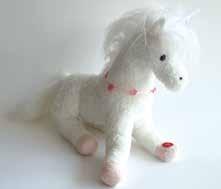
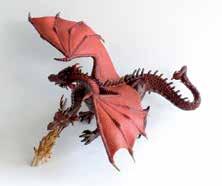

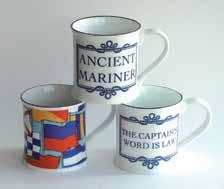





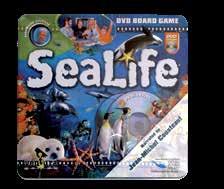


at annm.gov.au
shop online
Brass rum measure set in brass-inlaid box $60 Members $54 Check, mate! Russian navy chess set $120.00 Members $108.00 HMAS Vampire model $25 each Members $22.50 HMAS Vampire mug $15 Members $13.50 Nautical mugs just for you $29.95 Members $26.96 Brass bell 6” $105 Members $94.50 4” $49.95 Members $44.96 Sealife game family holiday fun $49.95 Members $44.96 Mythic Creatures two-headed dragon $42 Members $37.80 Plush penguin with baby $55 Members $49.50 Single penguin bib brother $28 Members $25.20 Captain Clueless game family holiday fun $49.95 Members $44.96 Nautical cap to identify your role on board $22 Members $19.80 Mythic Creatures light-up unicorn Special exhibition price $22 Aussie Uckers game Navy traditions $40 Members $36
Australian National Maritime Museum
Open daily except Christmas Day
9.30 am to 5 pm (6 pm in January)
Darling Harbour Sydney NSW Australia
Phone 02 9298 3777
Facsimile 02 9298 3780
ANMM council
Chairman Mr Peter Sinclair am csc
Director Ms Mary-Louise Williams
Councillors
Rear Admiral Stephen Gilmore am csc ran
Mr Peter Harvie
Ms Robyn Holt
Dr Julia Horne
Emeritus Professor John Penrose
Mr John Rothwell ao
Ms Ann Sherry ao
Mr Shane Simpson
Mr Neville Stevens ao
Signals
ISSN 1033-4688
Editor Jeffrey Mellefont 02 9298 3647
Assistant editor Penny Crino
Staff photographer Andrew Frolows
Design and production Austen Kaupe Printed in Australia by GEON group
Advertising enquiries
Jeffrey Mellefont 02 9298 3647
Deadline end of January, April, July, October for issues March, June, September, December
Signals back issues
Back issues $4
10 back issues $30
Extra copies of current issue $4.95 Call Matt Lee at The Store 02 9298 3698
Material from Signals may be reproduced only with the editor’s permission 02 9298 3647
For
GPO
2001 Australia www.anmm.gov.au
The Australian National Maritime Museum is a statutory authority of the Australian Government
more information contact us at:
Box 5131 Sydney NSW



















































 Submarine tours for people with vision impairment
Submarine tours for people with vision impairment

















































